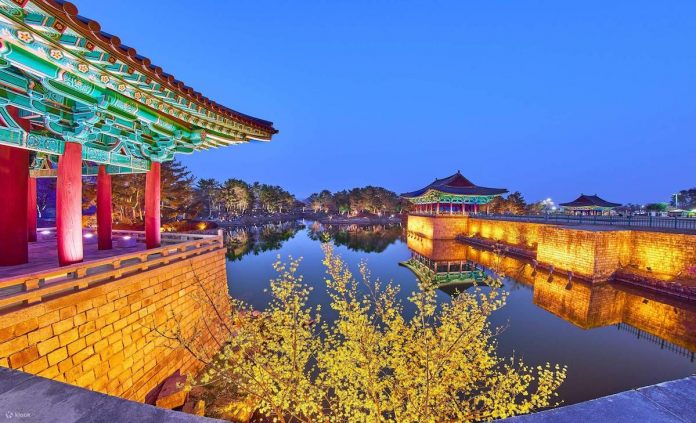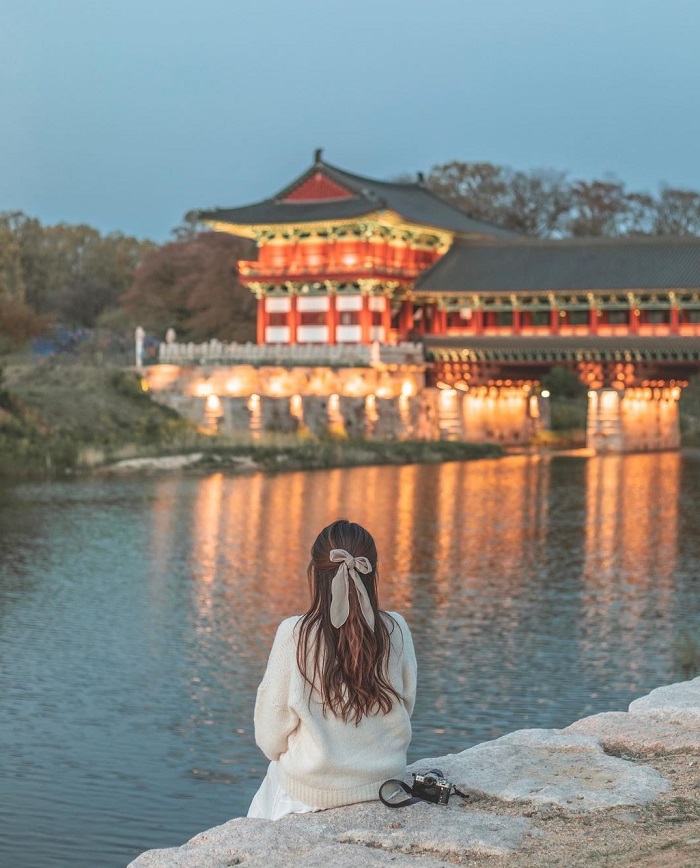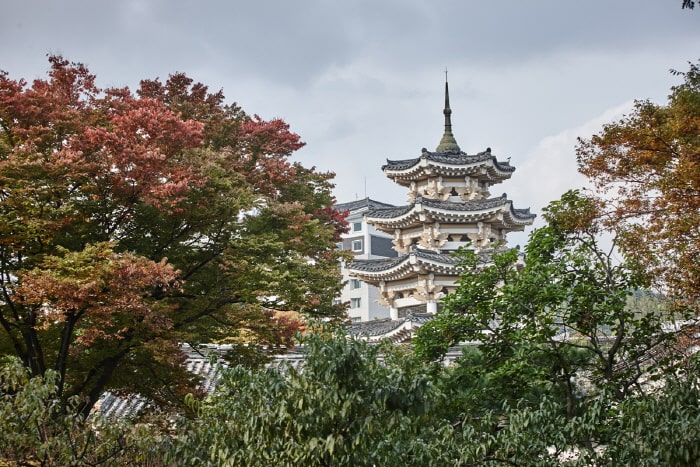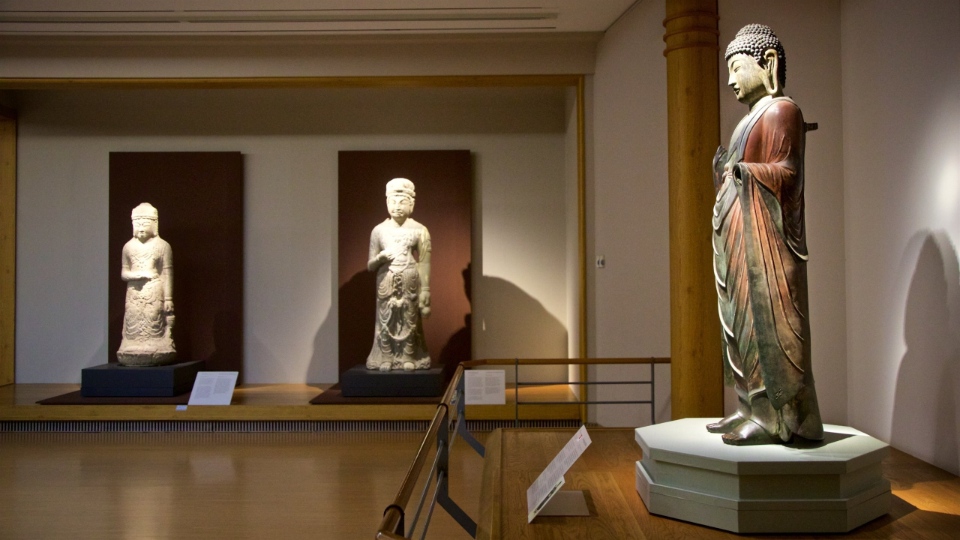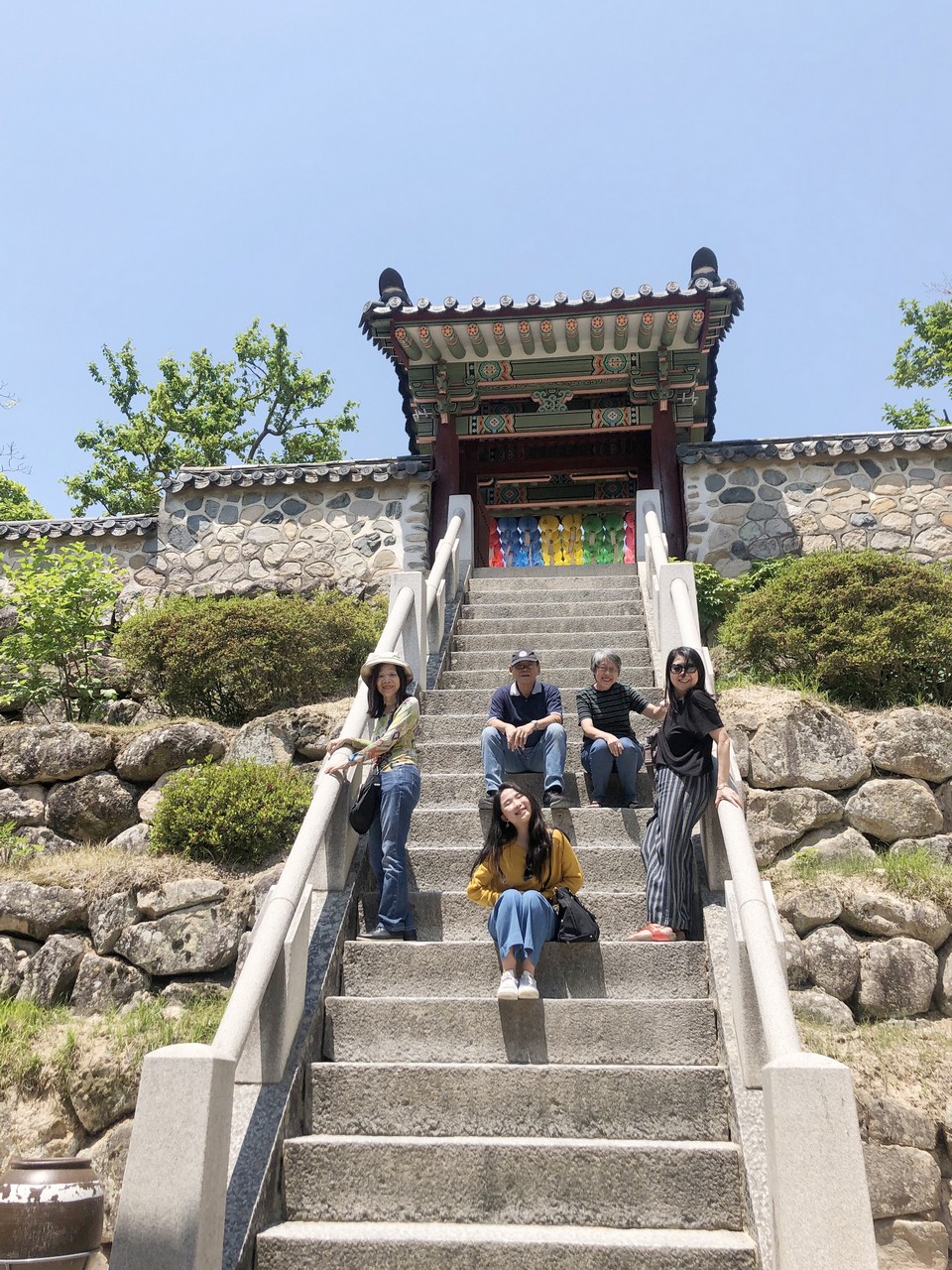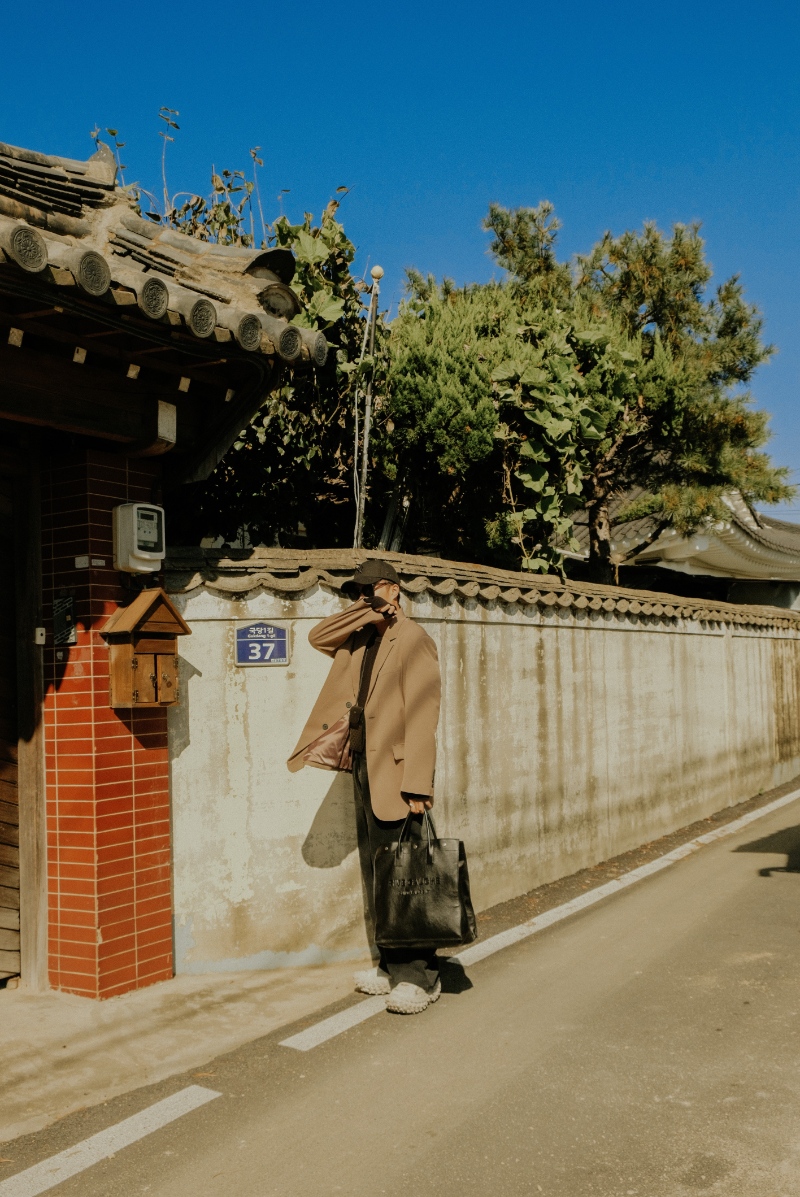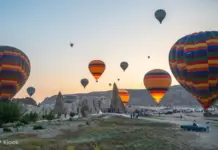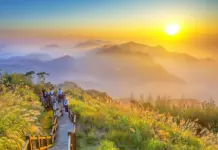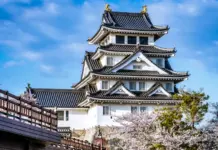Ever since my days of studying Korean history, I’ve always wanted to visit Gyeongju (Gyeongju) – the thousand-year-old ancient capital of Korea. If Seoul is dynamic and modern, then Gyeongju is a low note in the Korean tourist map. Gyeongju helps you discover ancient tourist attractions in the region, enjoy traditional Korean cuisine and learn more interesting things about the ancient capital of Korea. So, is Gyeongju worth visiting, what to do in Gyeongju and how to plan a perfect budget trip to Gyeongju for the first-time? Let’s check out our Gyeongju travel blog (Gyeongju blog) with the fullest Gyeongju travel guide (Gyeongju guide) from how to get to Gyeongju, best time to come, where to stay, best places to visit and things to do in Gyeongju to find out the answer!
- Gyeongju day trip — What to do in Gyeongju & how to explore Gyeongju in 1 day perfectly?
- Gyeongju 1 day itinerary — How to spend one day in Gyeongju, South Korea
- Discover Namsangol Hanok village: Preserving the quintessence of Korean culture
- The FULLEST Jeollanam Do travel guide: How to get there, best time to visit, top things to do in Jeollanam Do & MORE
- The ULTIMATE Guide to Gangwon: How to get there, Top attractions & what to do in Gangwon
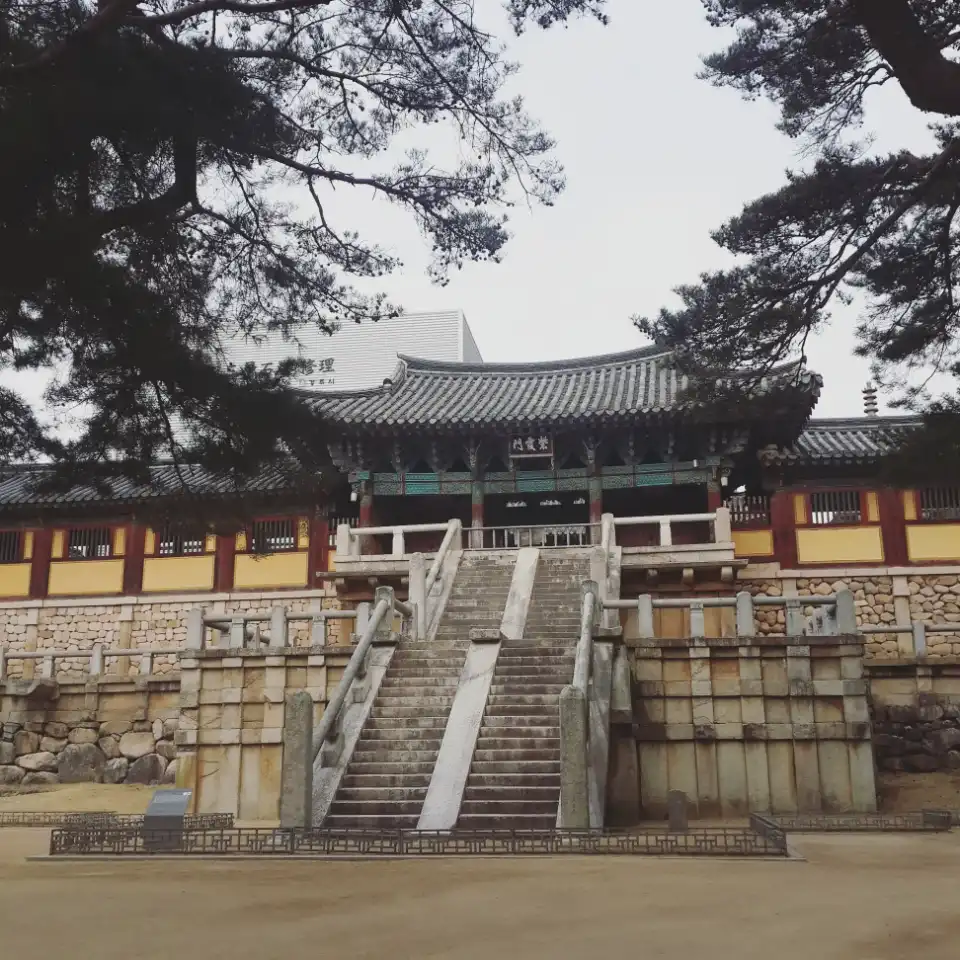
The country of Korea is mainly known for its modern towards future. And when you visiting big cities like Seoul and Busan, you can see this everywhere with all the towering buildings, super bright city lights and high speed internet. However, there are still plenty of cultural destinations where visitors can get a glimpse of Korea’s glorious past. One such destination is Gyeongju, the capital of the ancient kingdom of Silla, home to some of the finest Buddhist art in the Far East.
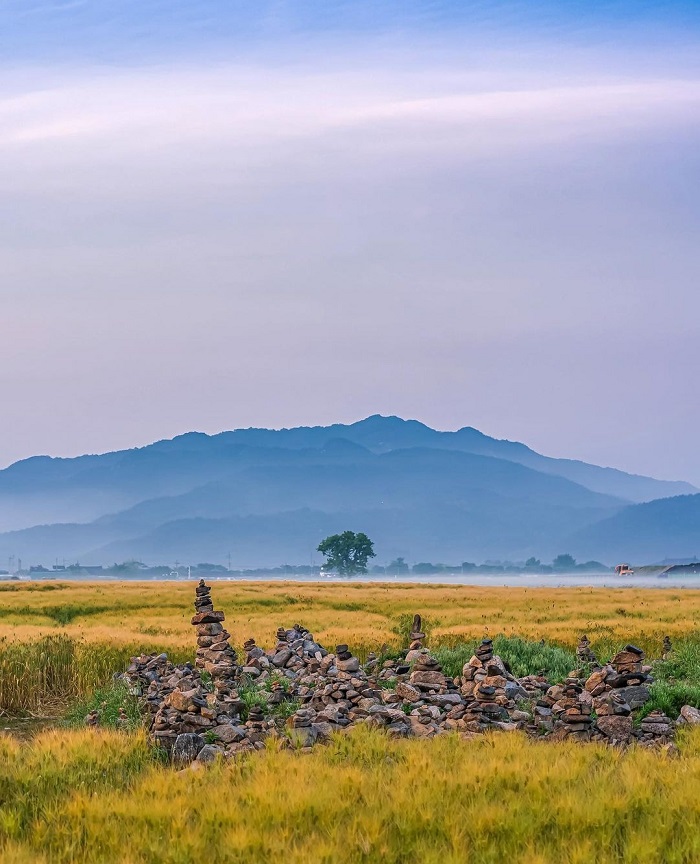
If you enjoy ancient cultures and traditions, take a day trip to Gyeongju, the ancient capital of Korea. Here is the detailed guide to Gyeongju for you!
Overview of Gyeongju (#Gyeongju travel blog)
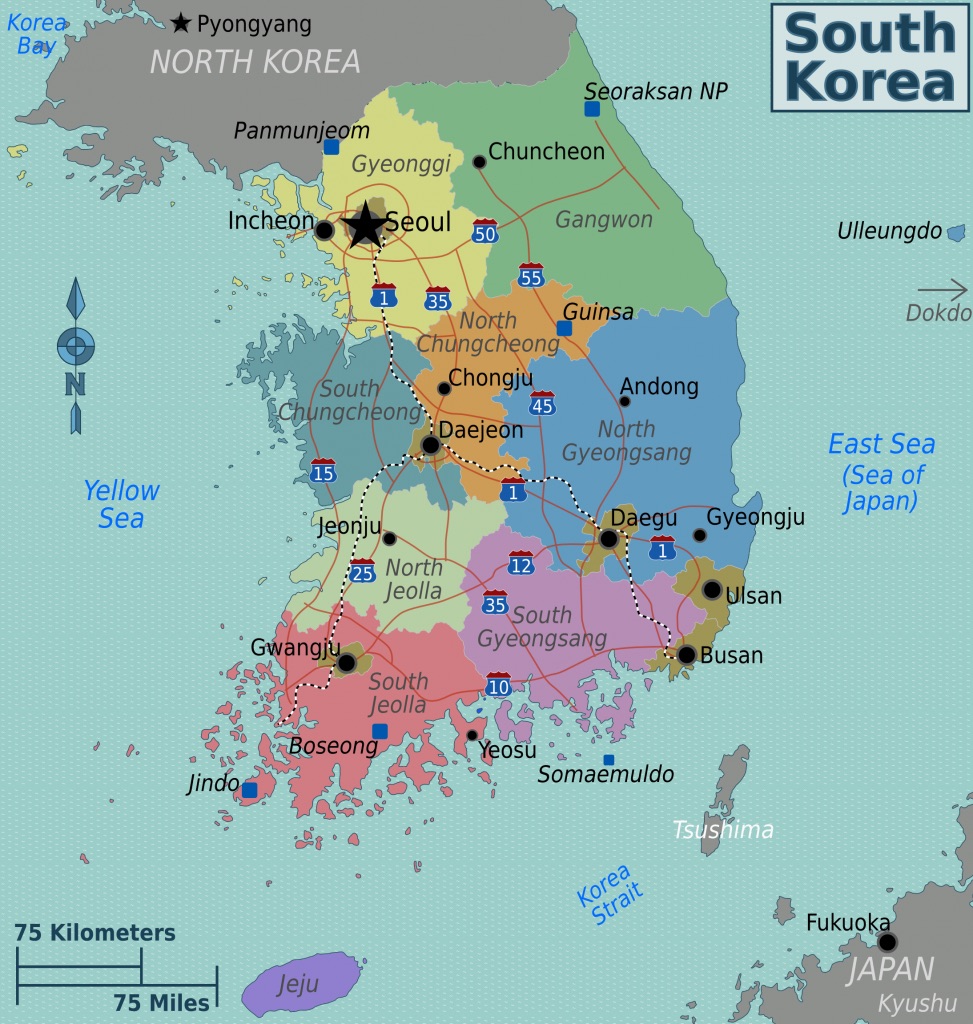
Gyeongju is a city located in the North of Gyeongsang Province, near the southeast coast of mainland Korea. It is an hour’s drive or bus from Busan and is a perfect day trip for those looking for a unique cultural experience. Gyeongsang Province has the largest area in Korea, including North Gyeongsang and South Gyeongsang, is the center of culture, history, preservation and saving of traditional customs and quintessence of Korea.
Like Vietnam and China, the Korean peninsula also had the Three Kingdoms period. The kingdom of Silla (Shilla) conquered Baekje and Goguryeo and established a new dynasty, the unified Silla. This is the first unified kingdom on the Korean peninsula, the Silla dynasty is also one of the oldest surviving dynasties in Asian history with nearly 1000 years. Many scholars liken Gyeongju to the Hue ancient capital of Vietnam.
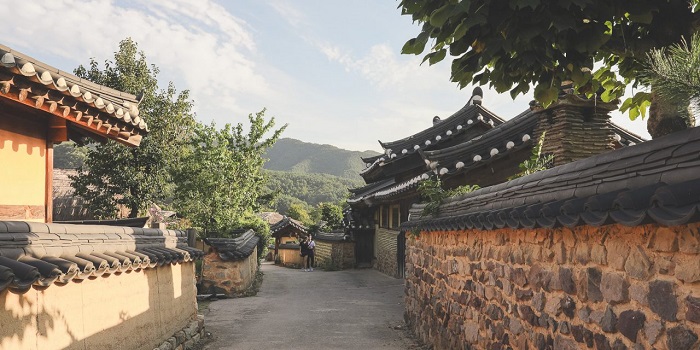
Gyeongju is now known as a “museum without walls” and is one of the most popular tourist attractions in Korea, especially for visitors interested in the cultural heritage of the Silla dynasty and the architecture of Joseon Dynasty.
During the period from 57 BC to 935 AD, Gyeongju served as the capital of the Silla kingdom. With a history of thousands of years, today when traveling to Gyeongju, you will have the opportunity to visit many historical sites and precious cultural heritages.
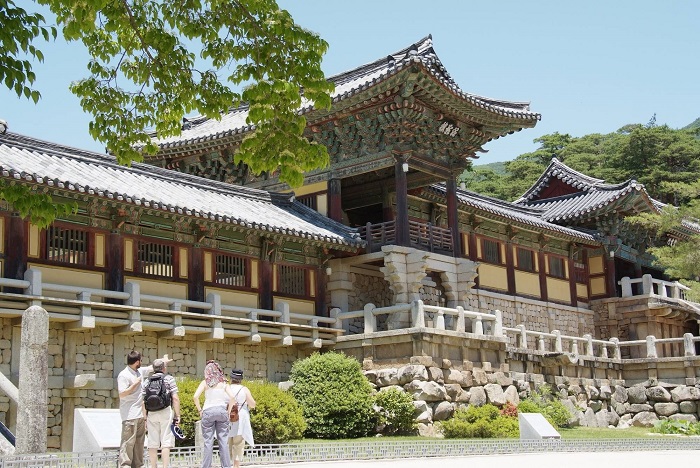
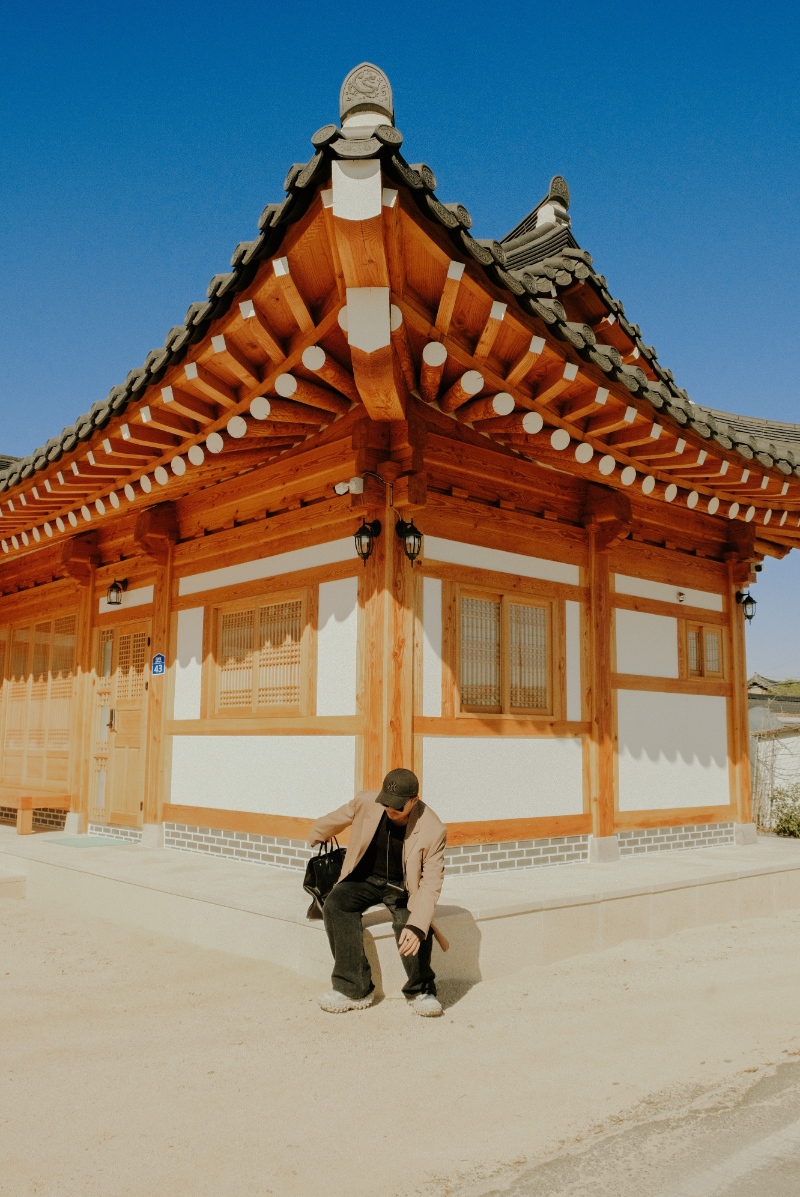
Once the former capital of the Silla kingdom, however, over the centuries, Gyeongju’s influence waned and it was no longer considered a major city. However, thanks to archaeological excavations carried out in the early 20s of the last century, Gyeongju’s historical significance has been recognized and it has become a cultural destination. In November 2000, Gyeongju Historic Areas was designated a UNESCO World Heritage Site.
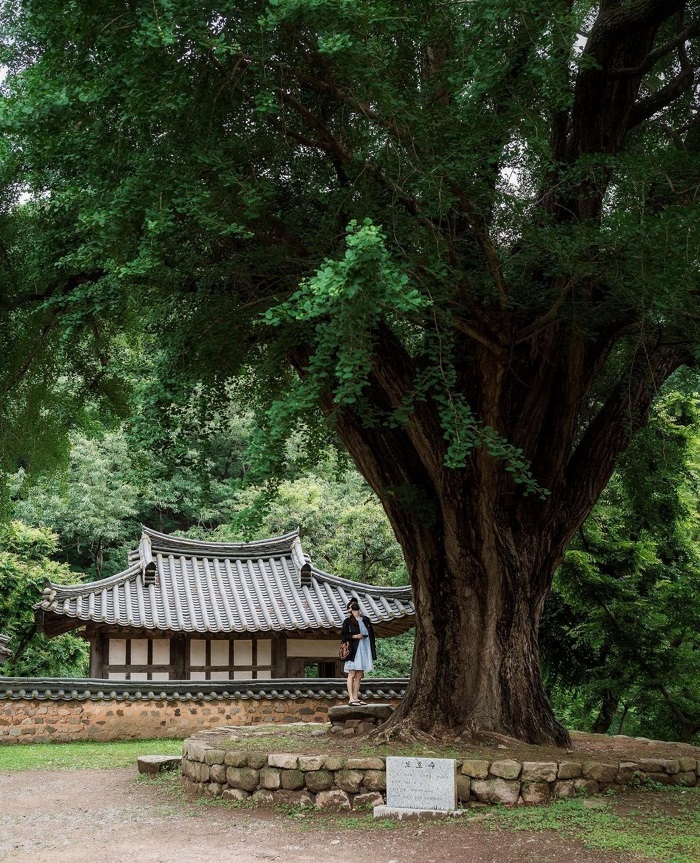
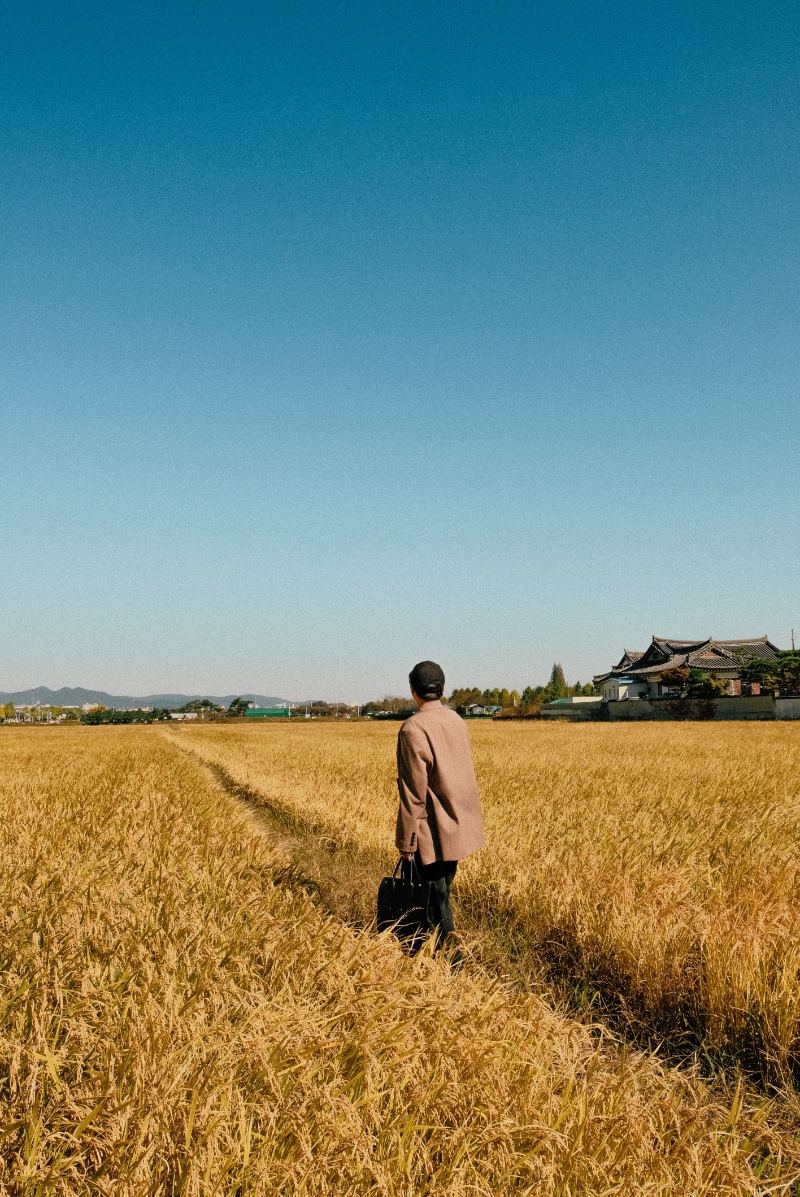
When is the best time to visit Gyeongju?
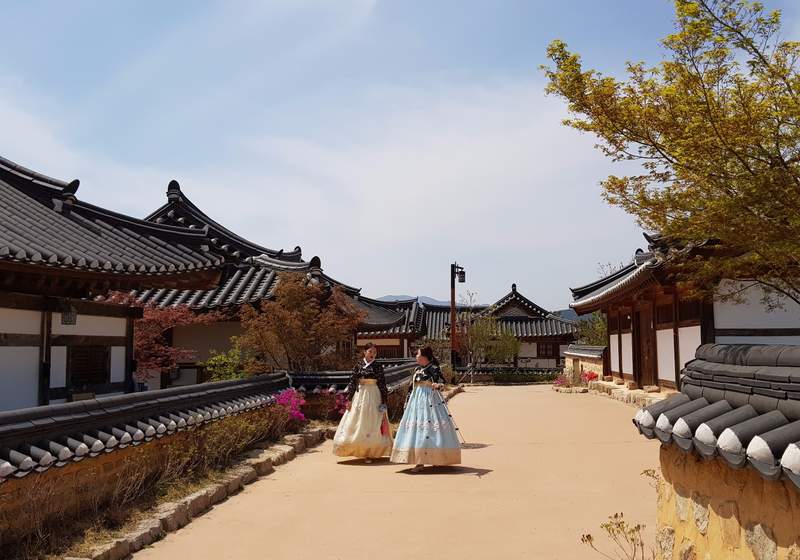
Gyeongju is a coastal city located. Therefore, compared to other cities, Gyeongju has a much cooler, temperate climate. Summers in Gyeongju are hot and humid and winters are relatively cool. The period from June to August every year, in Gyeongju often has a monsoon. The average annual rainfall is about 1,091 mm and the average temperature is about 12 degrees Celsius.
The peak tourist season in Gyeongju usually takes place in April and May. However, you should not go at this time because of hotel prices will be very expensive, you should go in December every year.
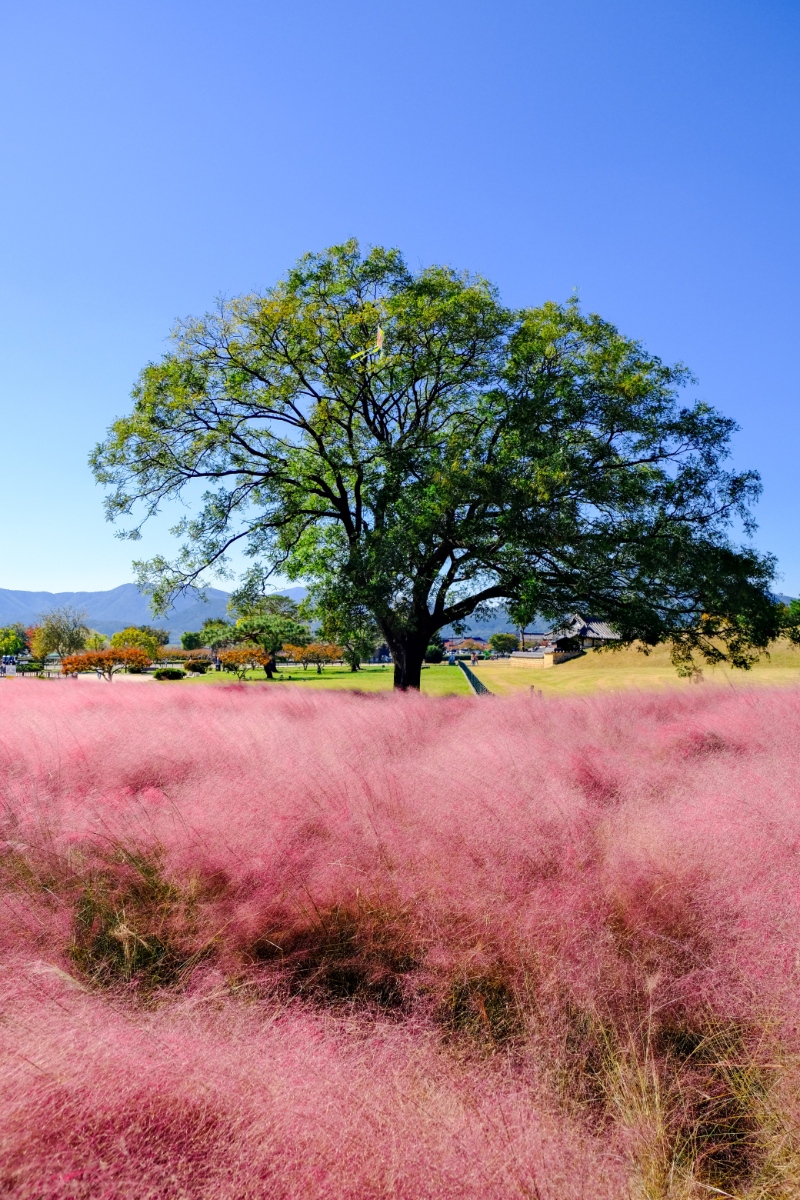


With the characteristics of Korean weather, visitors can travel to Gyeongju at any time of the year. Especially if you love flowers, you can come here from March to April. This time is cherry blossom season, very romantic and pleasant weather. In addition, the fields of canola flowers are also at the same time bright yellow swaying in the wind.

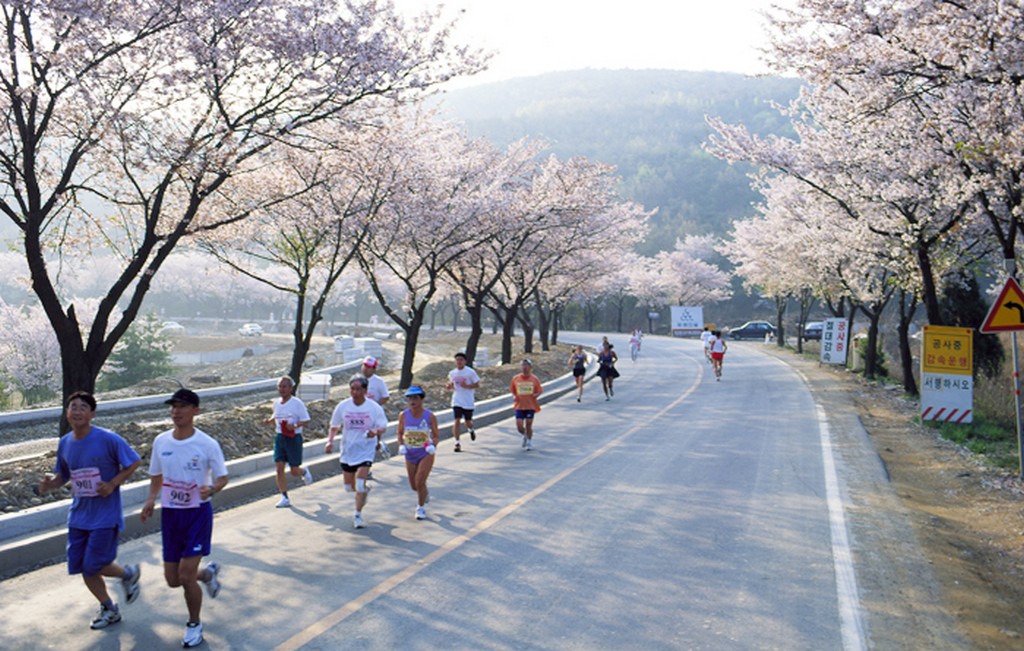
How to get to Gyeongju? (#Gyeongju travel guide)
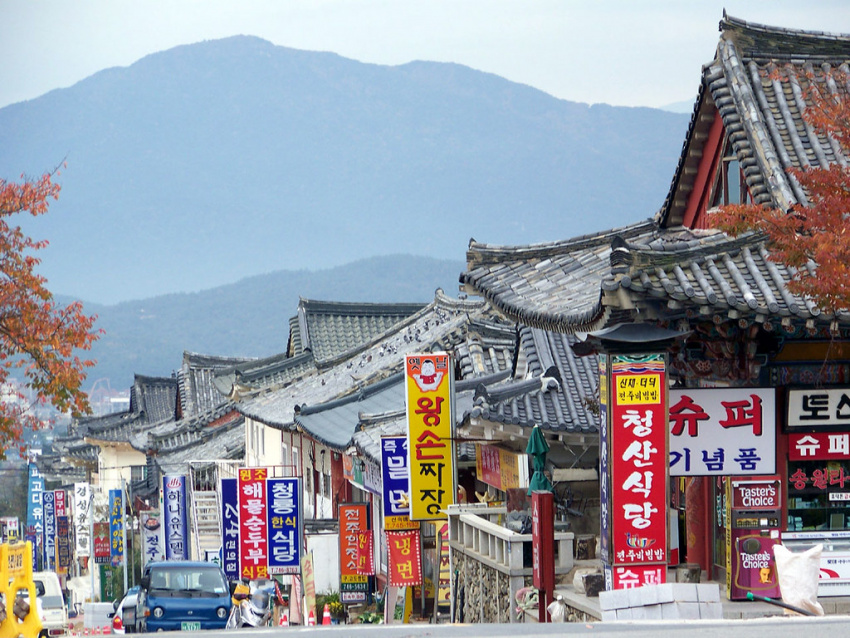
By plane
Currently, the city of Gyeongju does not have its own airport. However, if you want to go by plane, you can still go to the airport in Busan or Ulsan airport. From these airports, you can getting to Gyeongju city by bus or train.
By bus
From cities like Daegu, Pohang, Busan or Seoul, there are daily buses to Gyeongju. The travel time by bus from Seoul to Gyeongju is around 4 hours. From the cities of Daegu, Pohang or Busan, it only takes you about 40 minutes to reach.
From Seoul
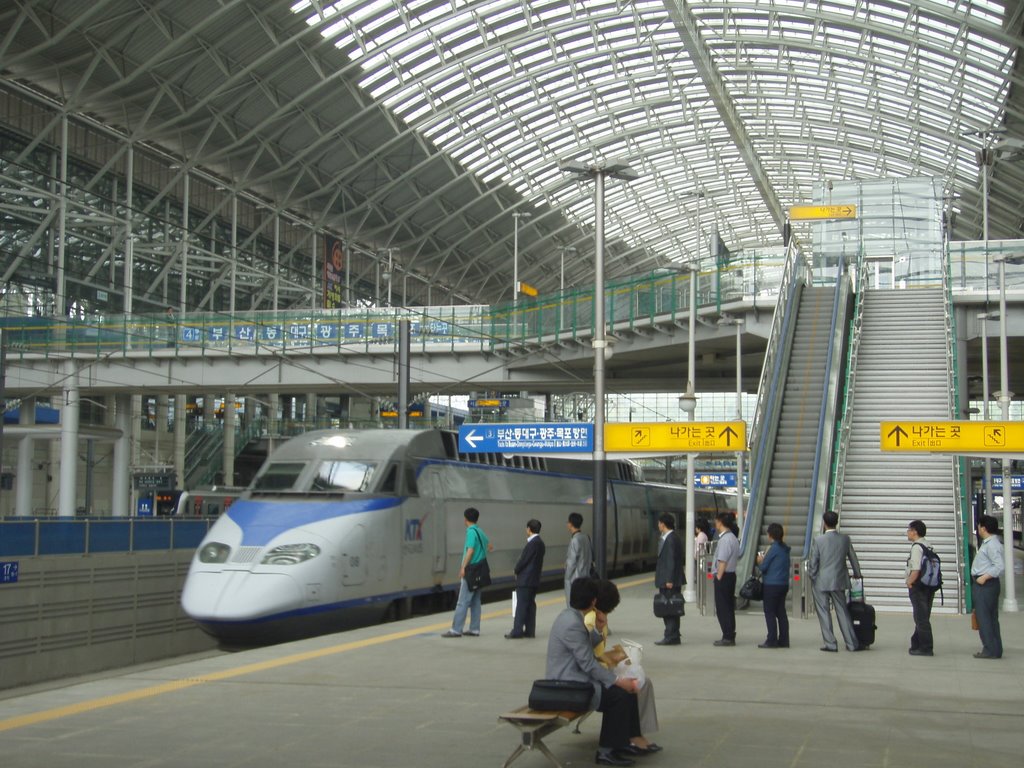
The most convenient and fastest way to get from Seoul to Gyeongju is by train. The KTX high-speed train takes about 2 hours and 10 minutes, and is only 15 minutes from Busan. It arrives at the city’s new train station (Singyeongju). From there you can take the bus to the center. It takes about 15 minutes through the verdant mountains to reach Gyeongju.
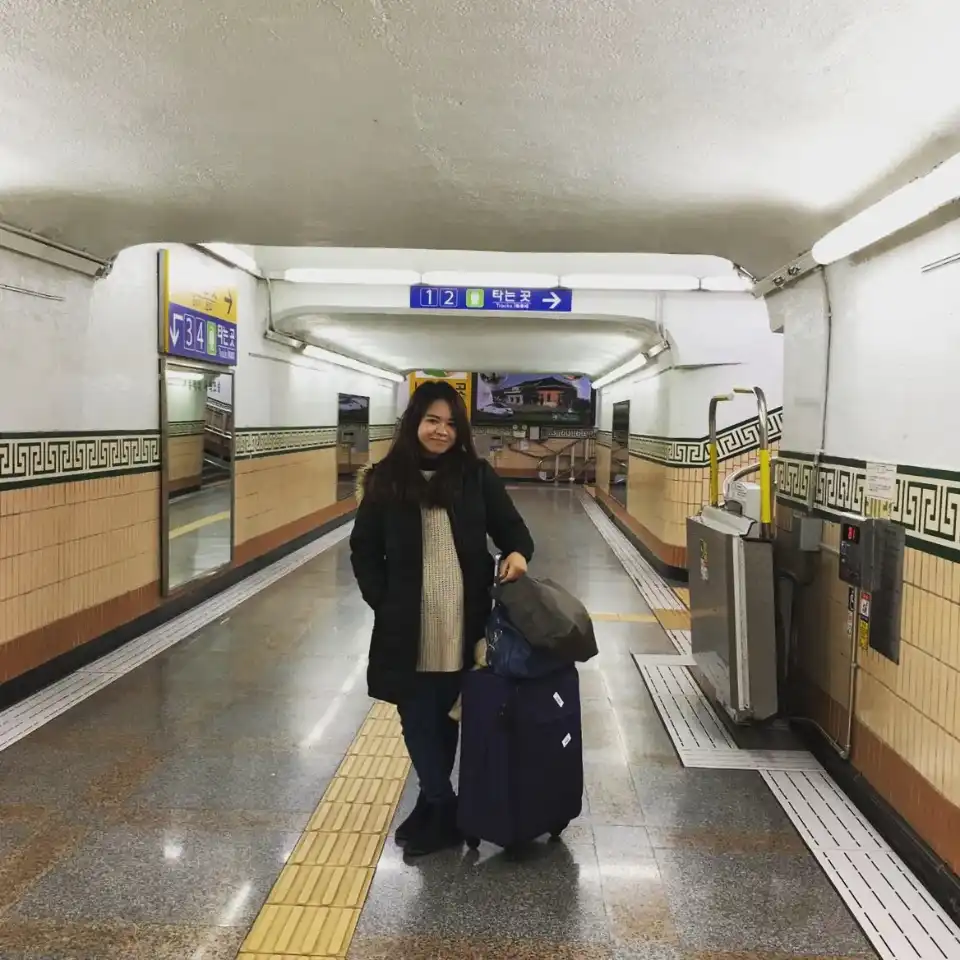
It should be noted that there are two train stations in Gyeongju City, Gyeongju Station, which is 10 minutes from the city center, and SinGyeongJu Station, which is up to 30 minutes by taxi from the city center.
From Busan (#Gyeongju travel blog)
By Air: The nearest international airport to Gyeongju is in Busan. There is also an airport in Ulsan. You can take the airport shuttle from Incheon (Seoul), Gimhae (Busan) and Ulsan straight to Gyeongju.
By car: The bus ride from Busan to Gyeongju takes about 60-90 minutes via the highway. First, head to the Gyochon Traditional Village and explore the surrounding areas from there. You can use Waze or Korean GPS for navigation.
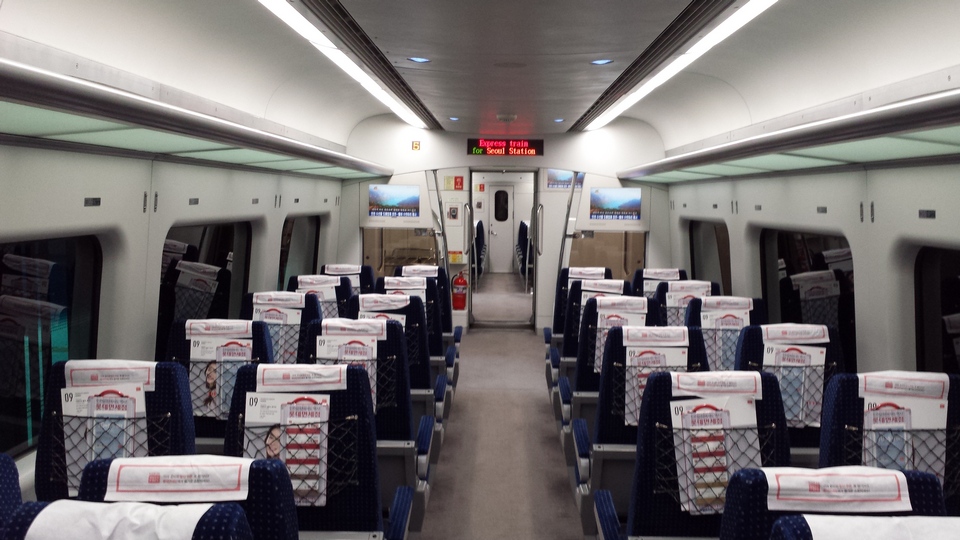
By KTX train: I went from Busan to Gyeongju. So I documented the way to get to Gyeongju for anyone interested in. From Busan Station there is a KTX train to SinGyeongJu Station, it only takes about 40 minutes, this station is a bit far from the center so it costs a taxi to getting to the city center, the train usually doesn’t go through GyeongJu Station (the old station), but it pass through Bulguksa Station which is a train station near the Buddhist temple which is the main tourist attraction of GyeongJu, so if you travel for 1 or 2 days on weekends, with little luggage, you go straight to the temple to visit, then take a bus to the center to see the rest of the spots.

I left in the afternoon, and with bulky luggage, I went to the hotel first, overnight there and then visit the next day, so going from Busan Station is very inconvenient. An acquaintance in Busan suggested to me to take the Dongdaegu-Bujeon train, which is a regular train, taking 1 hour and 50 minutes from Bujeon Station to Gyeongju Station, which is located only 10 minutes by taxi from the center. Busan and Bujeon stations are both located in the city of Busan, are two adjacent train stations, 22 minutes apart. The price of KTX train and regular train is also slightly different.
You can also choose a suitable itinerary. See information about trains and schedules at http://www.letskorail.com/
Getting around in the city of Gyeongju
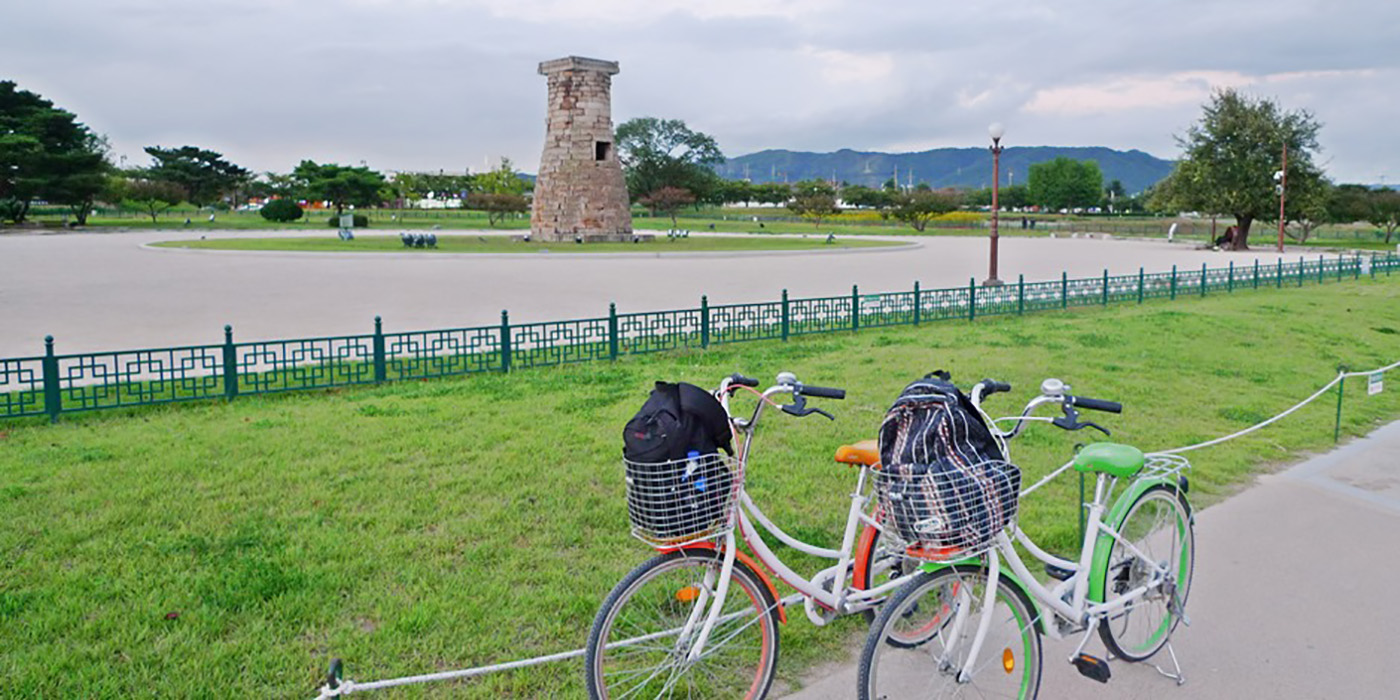
With the feature of many signs, being a quite ancient city, the means of transport you should consider is a bicycle, electric bicycle or motorbike. A simple bike is enough to take you to explore tourist attractions near the center such as Cheomseongdae, Anapji lake… Bicycle rental shops also abound in the city center, with rental prices ranging from 7,000 to 10,000 won/day.
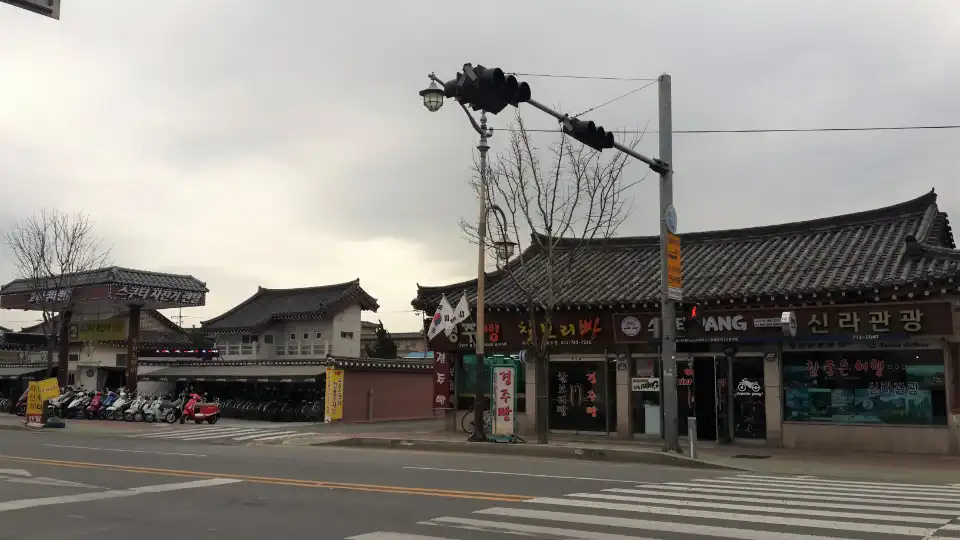
Gyeongju travel experience in terms of transportation is that, if you want to go further, for example Bulguksa Buddhist temple, you choose to take the inner city bus. The bus system in this city is generally convenient for every visitor. The stops near any relic are named after that relic, so there’s no fear of getting lost. The stops have notes in English and Korean and the staff is very supportive.

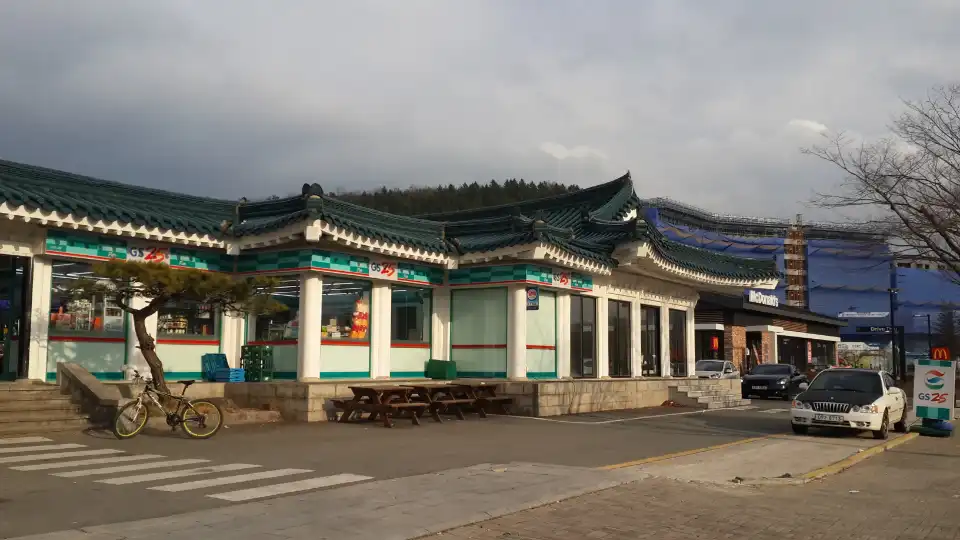
The tourist information counter is right next to the Bus Terminal and the main monuments all have English-speaking staff, extremely dedicated guides.
Where to go, what to do in Gyeongju (#Gyeongju blog)
With all the cultural and historical richness in the region, Gyeongju is a major tourist destination for both locals and foreign visitors. In such a compact area you will be able to see 1,000 years of Silla’s heritage as well as fine examples of Buddhist art and relics.
In the old town there are Daereungwon Tomb Complex, Cheomseongdae astronomical observatory, Anapji Lake which is beautiful at sunset and shimmering in the evening lights. Near Anapji Lake, there is a national museum and a 3D cinema about life in the Unified Silla period. About 1 hour by bus from the center of Gyeongju, there is the historical site of the National Buddhist Temple of Bulguksa and Seokguram Grotto, which has been recognized by UNESCO as a tangible cultural heritage (I will be written in another article). There is also the ancient village of Yangdong, only 50 minutes from the central bus station.
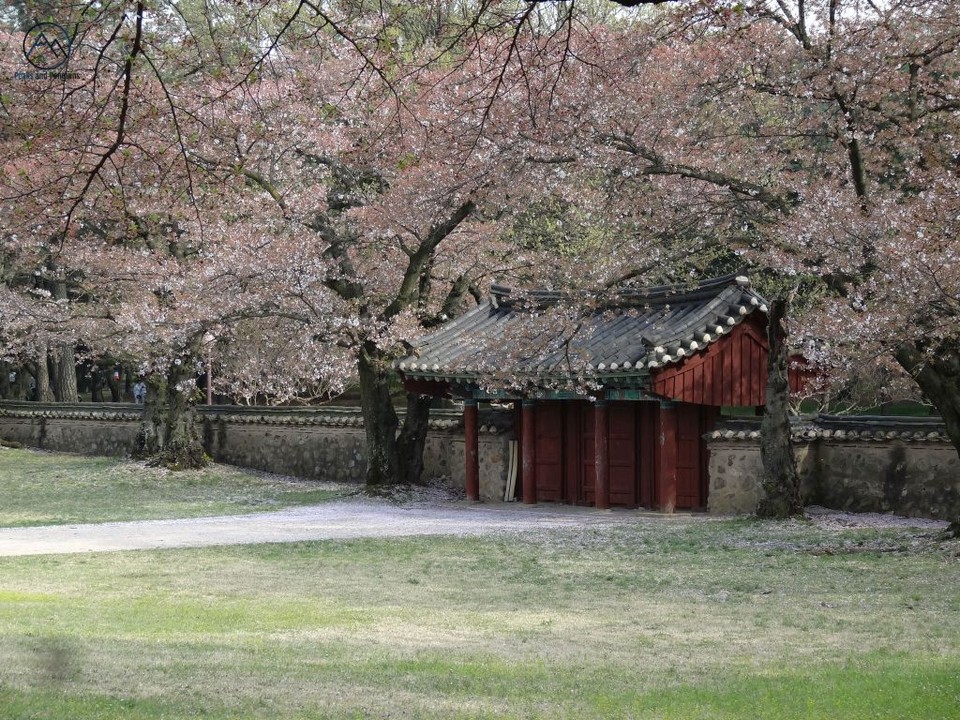
Visiting the remains of Namsan Mountain (#Gyeongju travel guide)
The first place that you should visit when you have the opportunity to come to Gyeongju city is the Namsan mountain. It bears the imprint of the Silla period, where the people longed for a country with Buddhist beliefs. In the past, the Namsan mountain was home to many temples built during the heyday of the Silla dynasty.
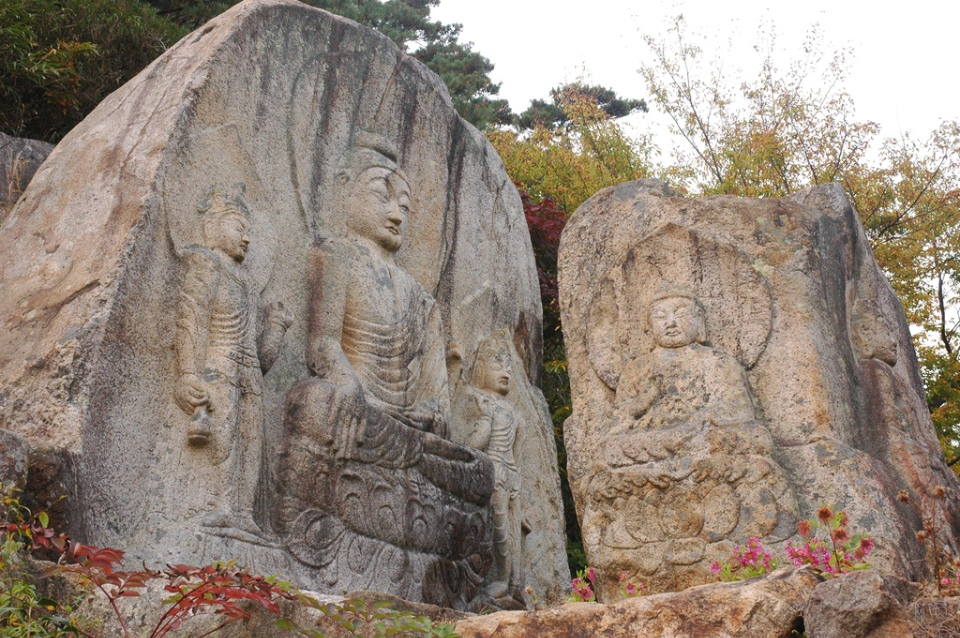
On Namsan Mountain, there are more than 100 Buddha statues such as sitting stone Buddha in Mireuk-bong Peak (The Great Statue of Maitreya Buddha), standing stone Buddha in Baeri, Buddha carved on cliffs in Chilbul-sa (Seven Buddhas Temple of Jiri-san), 100 stone towers and more then 150 temples and pagodas relics.
When you come here, you will be able to visit the ancient catacombs, the ruins of the palaces, the royal gardens of the Silla kings as proof of a brilliant civilization.
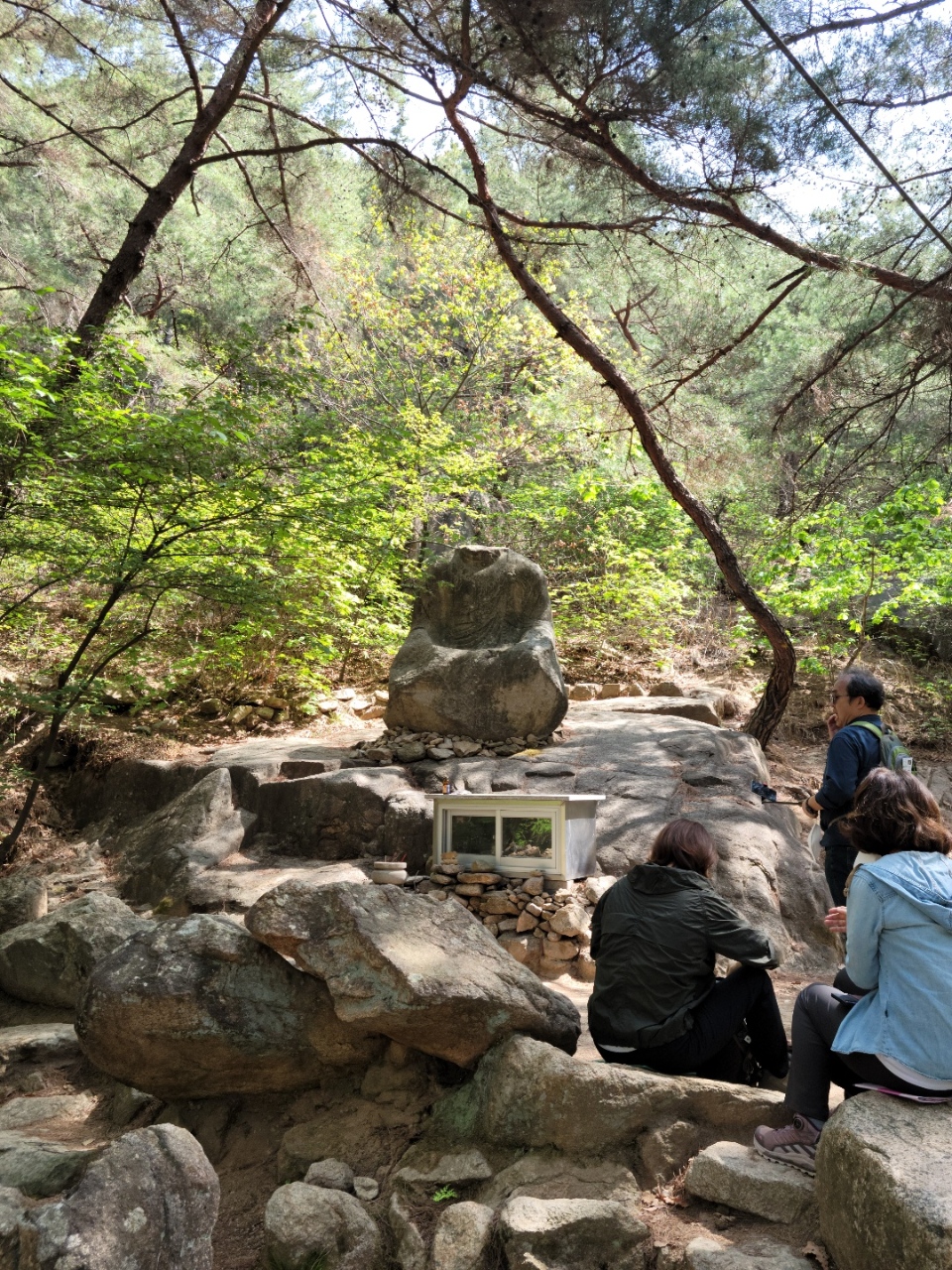
Not only can you admire the remaining historical ruins, you also have the opportunity to admire the beautiful scenery of Namsan Mountain.
Hiking through the woods leads to gurgling streams. More specifically, you can also play at the artificial rock spring of Poseokjeong, which was formerly the playground of the royal family.
Gyochon Traditional Village
Let start your Gyeongju tour at the Gyochon Traditional Village. If you arrive in the city at noon, this is also a great place to have lunch.
Traditional villages across Korea mostly consist of “hanok” or traditional Korean houses. Traditional Korean houses are generally eco-friendly. They are designed and built with non-polluting raw materials (such as earth, wood and stone) and designed to harmonize with their natural surroundings. Traditional Korean architecture also considers the house’s position in relation to its surroundings and is designed to endure cold winters and hot summers.
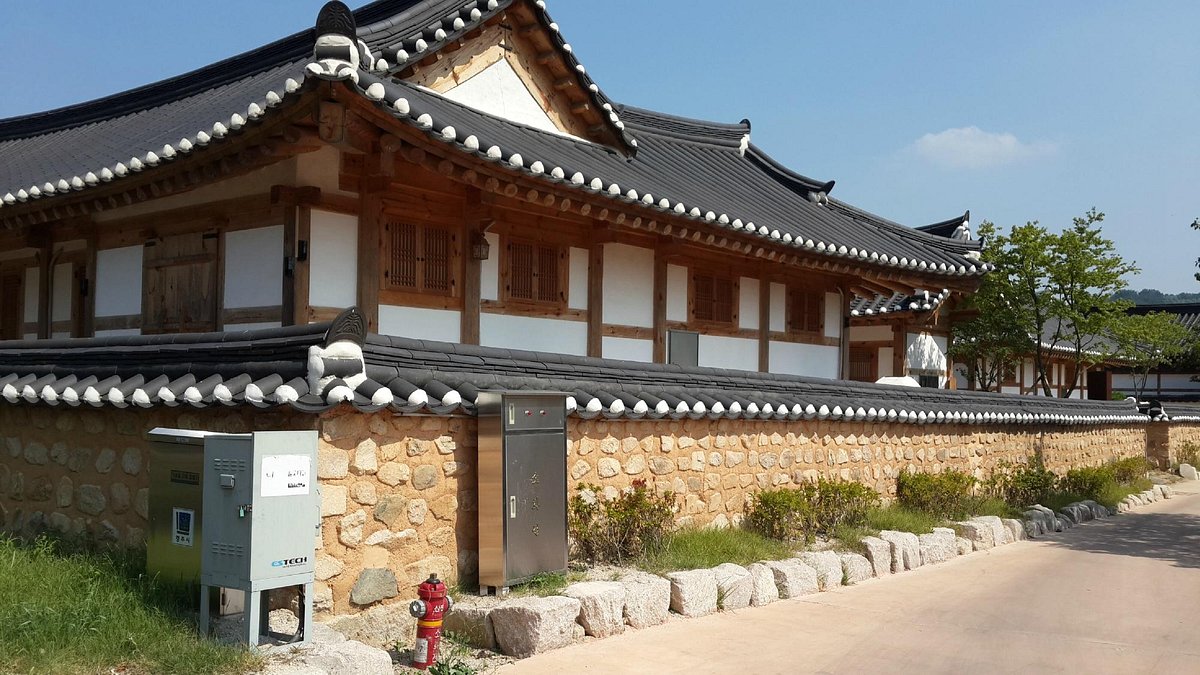
You can visit Gyochon Traditional Village, which is a hanok village that focuses on the life of the Choe clan. The Choe family was especially loved by their neighbors as they were said to be very impartial and generous with their wisdom and wealth.
In the village, you will find many traditional houses and restaurants specializing in traditional cuisine. You’ll also be able to take part in glassmaking classes, pottery workshops, and tea ceremonies.
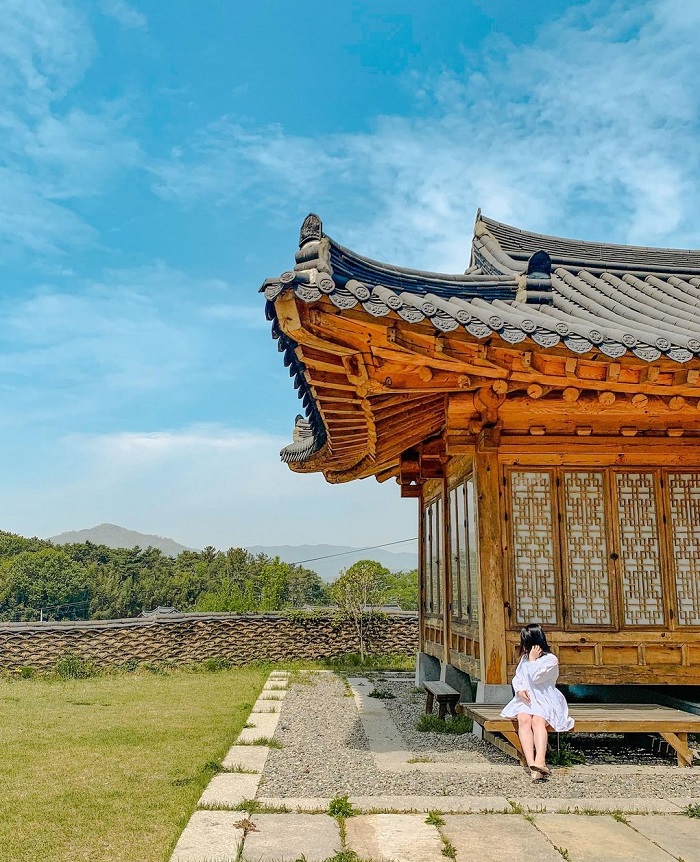
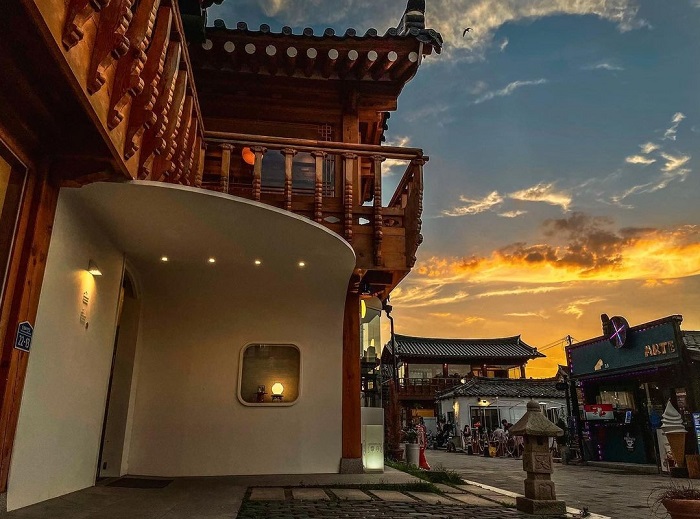
Address: 39-2 Gyochon-gil, Gyo-dong, Gyeongju-si, Gyeongsangbuk-do, South Korea
Hours: Open 24 hours
Yangdong Folk Village (Yangdong Village of Gyeongju)
One of Gyeongju’s UNESCO World Heritage Sites you should visit is the village of Wolseong Yangdong (Yangdong Folk Village). This small village has about 150 houses built between the 14th and 15th centuries.
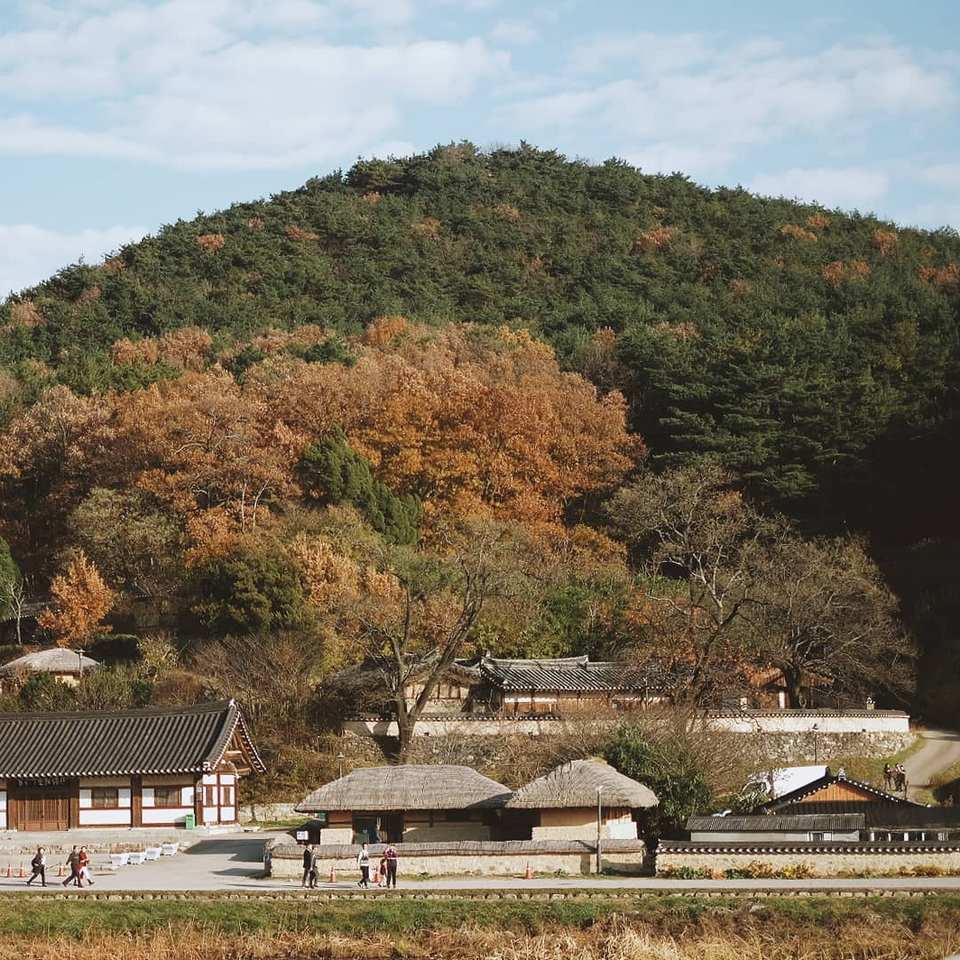
The village built between the 14th and 15th centuries is considered the most representative clan village in Korea. The village located at the foot of the Seolchang mountain surrounded by forested mountains, opposite the village is a large river and rice fields showing the culture of the ancient nobility in Korea.
The design of the houses here shows the class stratification of the nobility and the poor peasants. The houses clearly show the upper and lower hierarchy of the Joseon period.
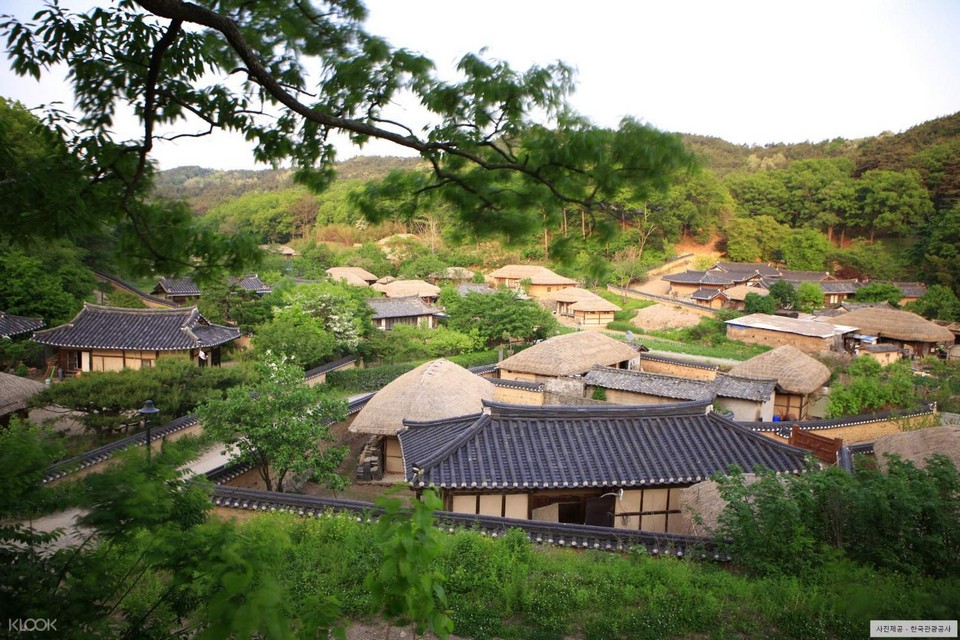
In the past, this place was mainly the residence of the Sohn and Lee family, so the village is also known as Oeson village. They built houses in different directions, not in the same direction, showing the development rivalry of the two clans.
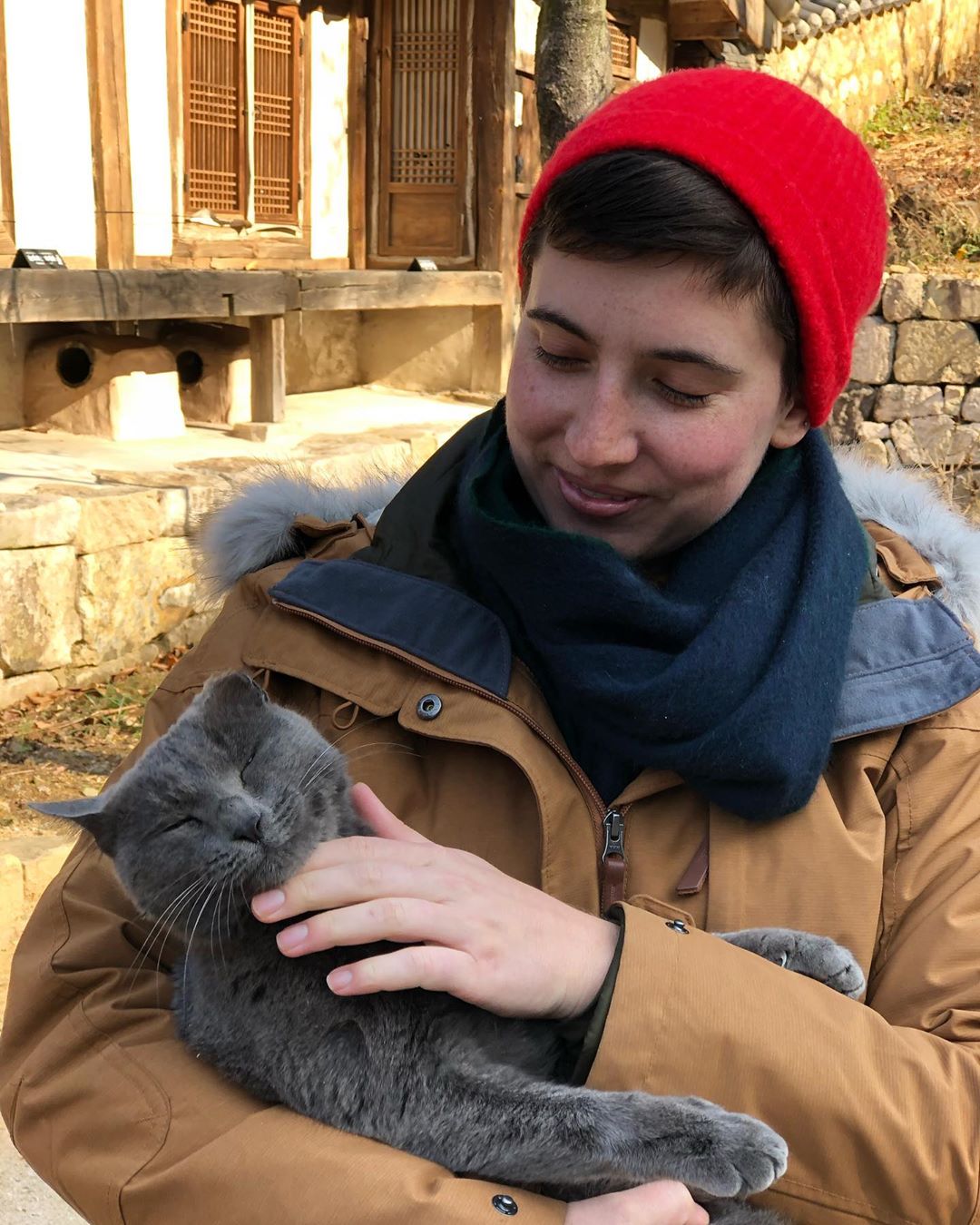

It is thanks to the diversity as well as the special architectural features of the famous sightseeing spot in Gyeongju, Korea that it has been classified as a world cultural heritage by UNESCO and described as one of the typical cultural villages of Korea.
Address: 91 Yangdongmaeuran-gil, Gangdong-myeon, Gyeongju-si, Gyeongsangbuk-do, South Korea
Hours: 9AM–7PM
Daereungwon Tomb Complex (#Gyeongju blog)
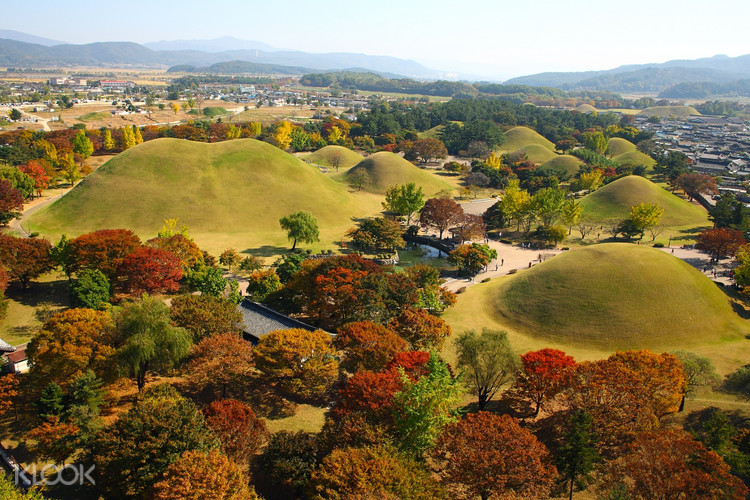
Coming to Cheomseongdae stone tower (star-gazing tower), don’t forget to visit Daereungwon royal tomb complex. South of the main observatory is the Gyerim forest and the Daereungwon royal tomb. It is a complex of many tombs of Silla kings and queens. There are 23 tombs out of 200 tombs in the relic complex. Each tomb was excavated and filled up to form large hills covered with green grass.
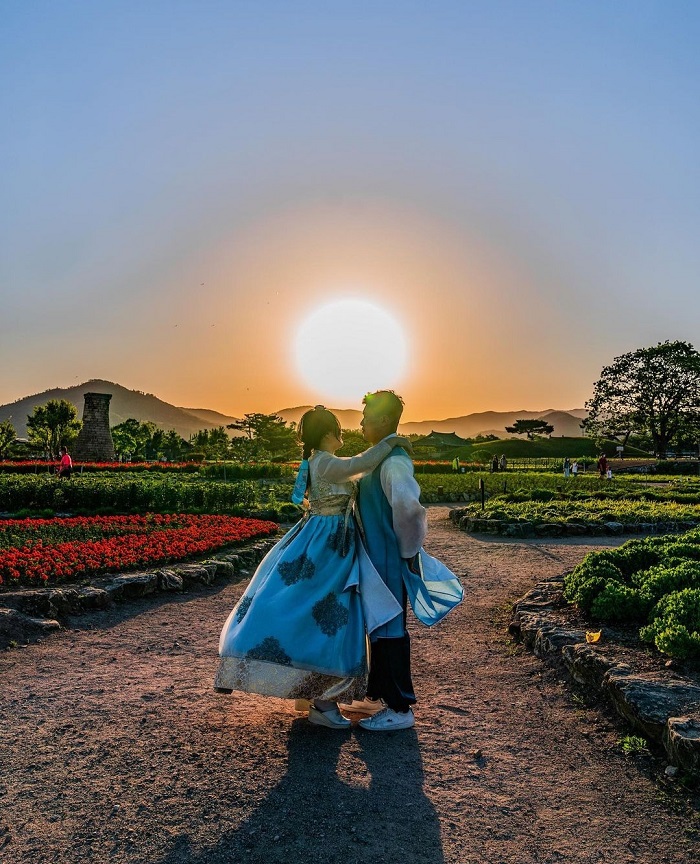
Prominent among the royal tombs of Daereungwon is the ancient tomb of Cheonmachong (Sky horse tomb) which is considered the largest in the center of the tomb complex as the resting place of a Silla king in the 5th – 6th centuries and was excavated in 1973. The Cheonmachong tomb has the only painting discovered from the Silla period, as well as relics showing the king’s lavish lifestyle. Hwangnamdaechong is the empress’s tomb, hidden more luxurious accessories.
More than 15,000 treasures were discovered here, in which the golden crown and gold belt of the king are displayed at the Gyeongju National Museum.
Some prominent tombs are open to visitors such as Gwoereung Tomb, Baeri Samneung Tomb, Nodong/Noéo-ri Tomb Park, Seoakre Gobungun Tomb, Kim Yushin Tomb, King Munmu’s Underwater Tomb…
Address: 31-1 Hwangnam-dong, Gyeongju-si, Gyeongsangbuk-do, South Korea
Hours: 9AM–10PM
Entrance fee: 2,000 won
Cheomseongdae Observatory
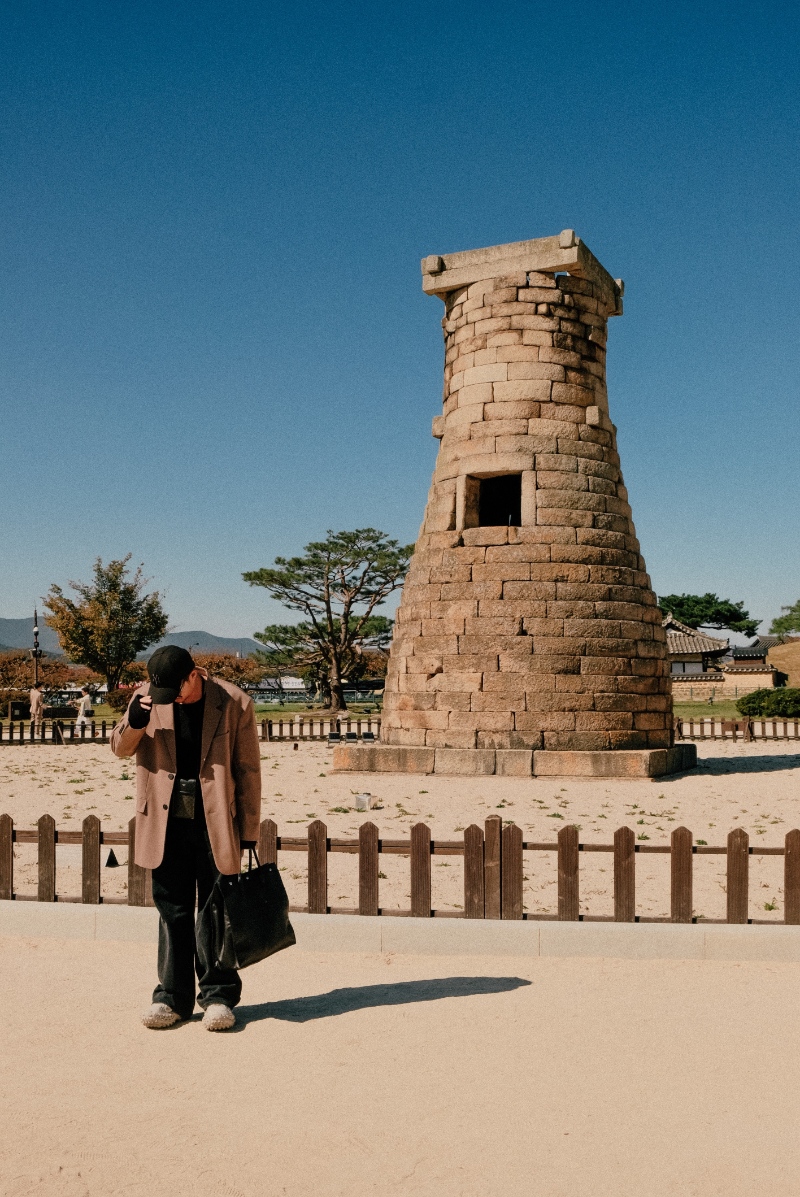
Near the royal tomb complex, you’ll find the Cheomseongdae observatory – the oldest surviving astronomical observatory in Asia. Cheomseongdae, which means “stargazing tower”, was built in the 7th century in the kingdom of Silla, during the reign of queen Seondeok of the Silla dynasty (632-647. It is 9.17 meters high and is made up of 362 pieces of cut granite, representing the 362 days of the lunar year, the stones are stacked in 27 layers. Each side of the tower has three stones representing 3 months in the period.
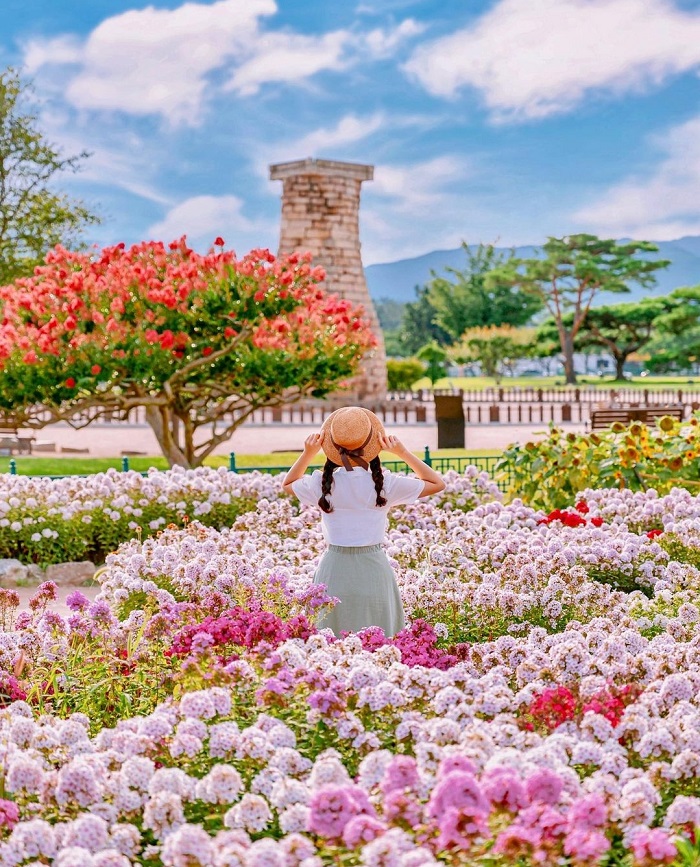
You may not know this observatory is Korea’s 31st treasure; predictive effect on nature, society and destiny. Not only famous for its historical values, the scenery around this work also amazes visitors with the vast fields of mustard flowers blooming in April.
It’s an important heritage site in the heritage complex of ancient Gyeongju capital. It was recognized by UNESCO as a world cultural heritage on December 20, 1962.
Address: 839-1 Inwang-dong, Gyeongju-si, Gyeongsangbuk-do, South Korea
Hours: 9AM–10PM
Donggung Palace and Wolji Pond (Lake Anapji)
From the ancient tomb complex, head to Donggung Palace and Wolji Pond, a man-made pond formerly known as Anapji.
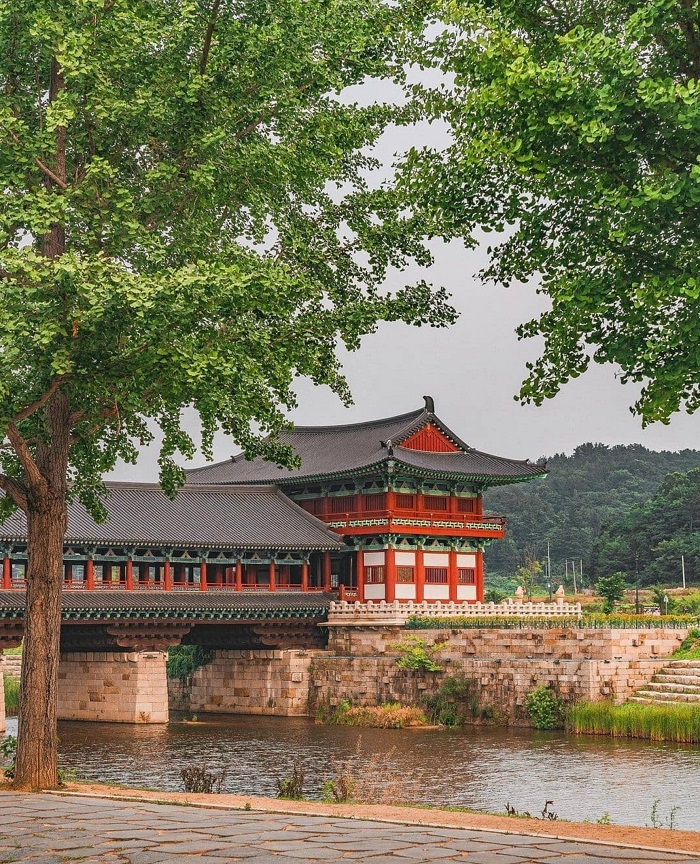
These are the remnants of a palace complex of ancient Silla, built by King Munmu according to Taoist aesthetics in 674 AD. After the fall of Silla, the pond was abandoned and rebuilt only in 1974. During this time, excavations have uncovered many archaeological remains, which are now on display in the complex.
Lake Anapji was loved by the royal class as a resort. Under Silla, Lake Anapji was famous for its sophisticated architecture and poetic scenery. If you have the opportunity to go to Korea in June or July, you will be able to see lotus flowers blooming all over Lake Anapji.
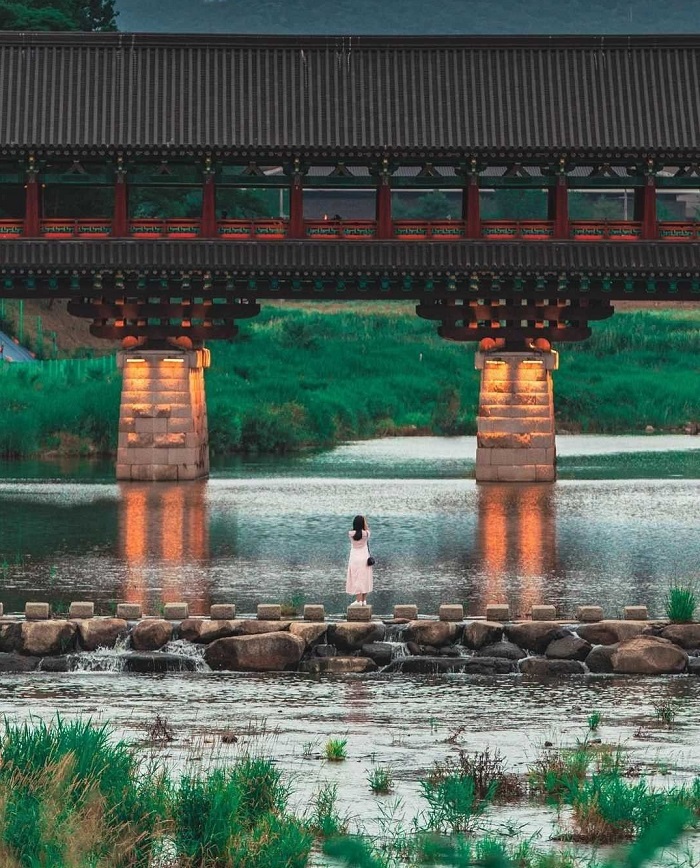
In the afternoon, visitors can admire the beautiful scenery of Anapji Lake and the sunset. Gently relax in the fresh and peaceful atmosphere of the ancient capital of Gyeongju. Relive the memories of a brilliant civilization in the past. This lake is especially beautiful at night if you happen to stay overnight in Gyeongju.
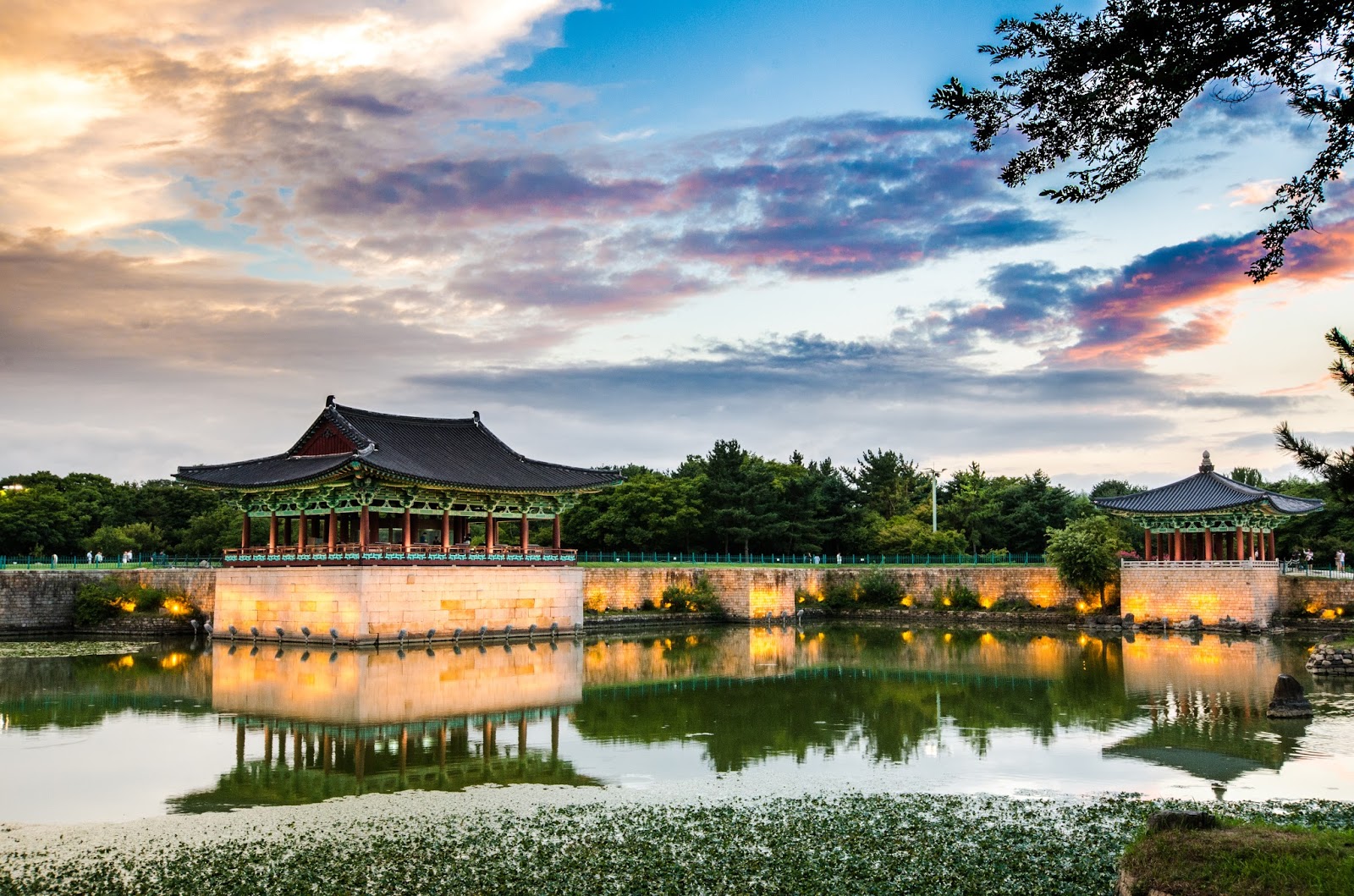
Address: 102 Wonhwa-ro, Inwang-dong, Gyeongju-si, Gyeongsangbuk-do, South Korea
Hours: 9AM–10PM
Bomun Tourist Complex
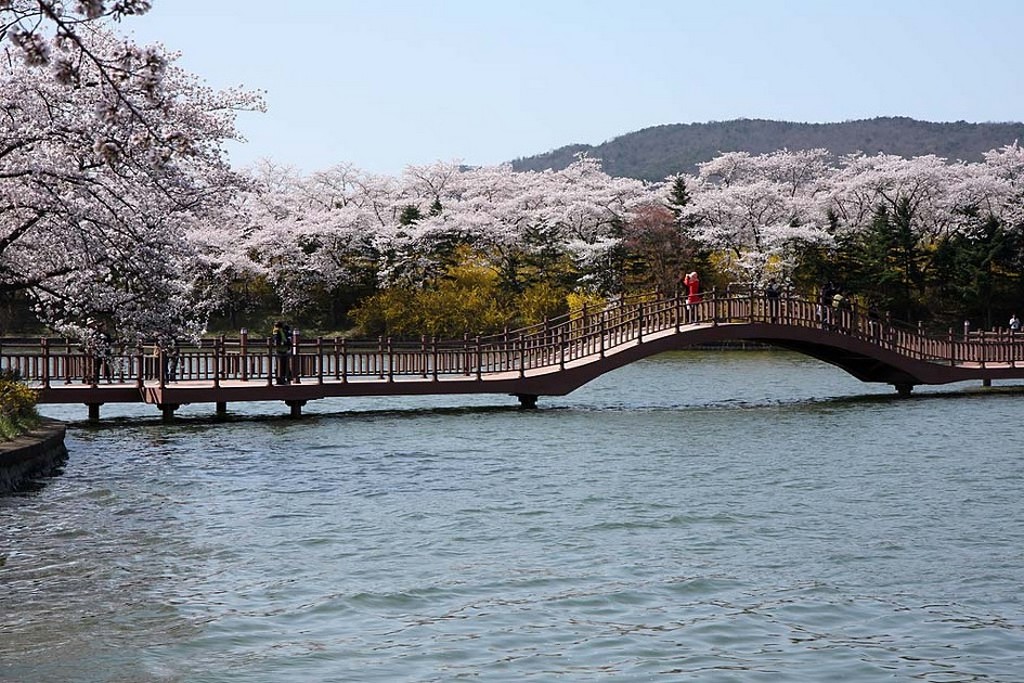
The Bomun Tourist Complex is centered around Bomunho Lake (Sinpyeong-dong, Gyeongju-si, Gyeongsangbuk-do), about 10 kilometers east of downtown Gyeongju. This is a place where all kinds of services are concentrated such as luxury accommodation, golf courses, amusement parks… In which the highlight is Gyeongju World Amusement park (Address: 544 Bomun-ro, Gyeongju-si, Gyeongsangbuk-do, South Korea/Hours: 10AM–6PM; Saturday, Sunday: 10AM–8PM) – where there are countless rides and camping areas. Very attractive for groups of young people.
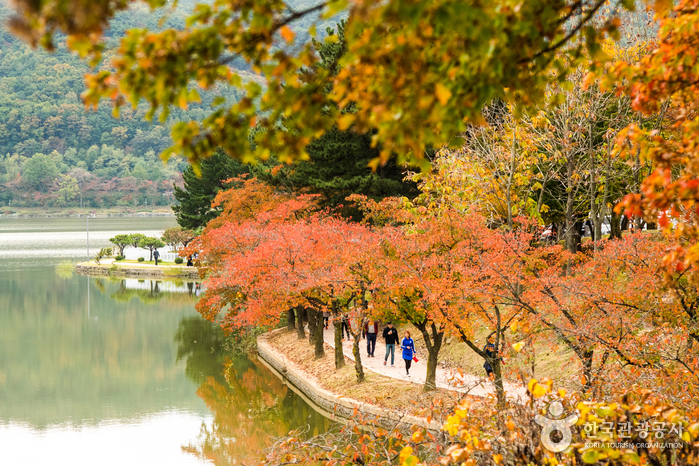
Hwanglidangil Street
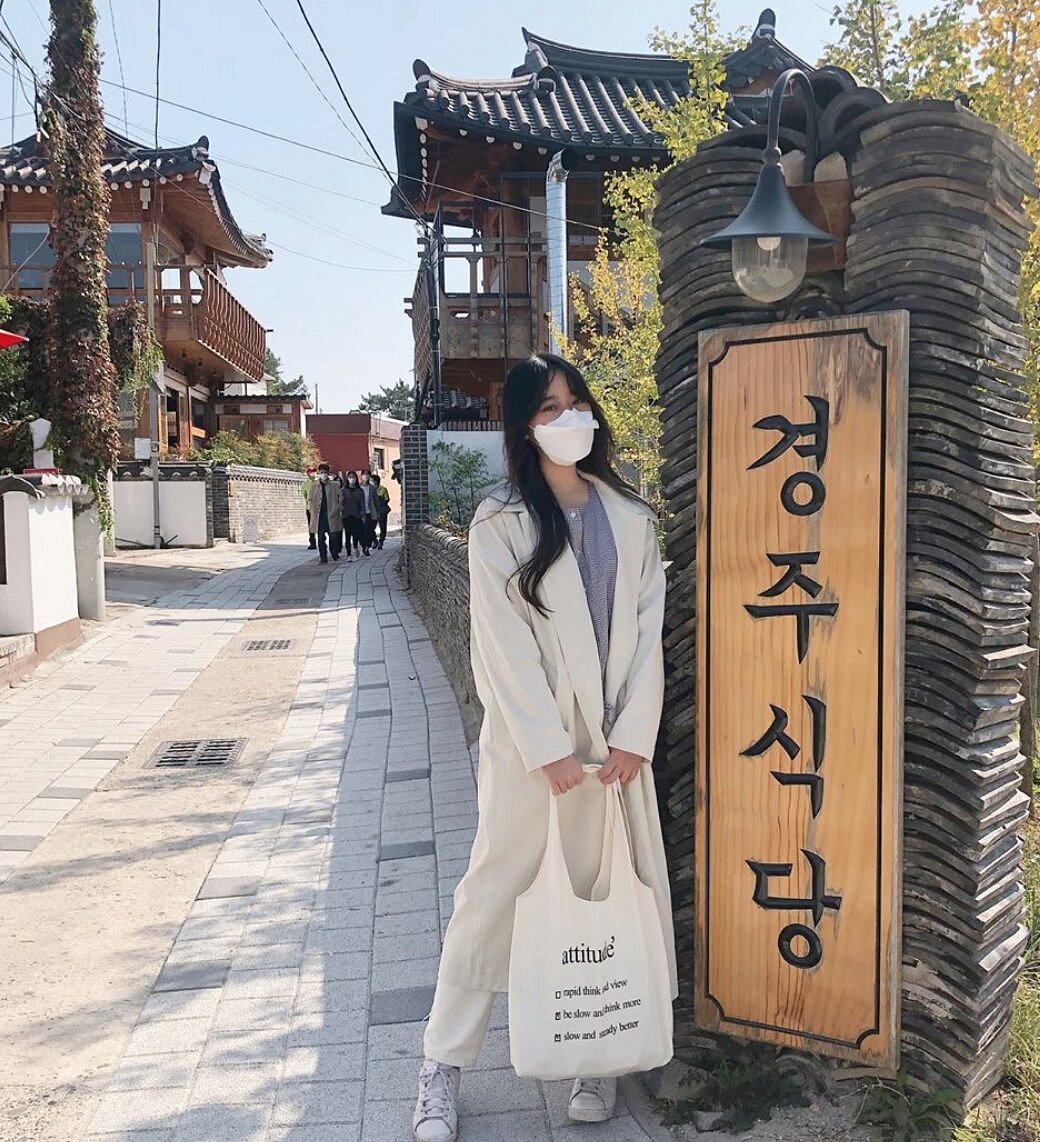
The street is extremely suitable for walking and relaxing. On the small old alleys are long rows of bustling eateries, cafes and small shops. Don’t forget to take a leisurely time at Hwanglidangil, stop by to sip a delicious cup of coffee. Some names can be mentioned: 대릉다원, 스컹크웍스, 오하이, 동경, 더클램프,…
Gyeongju National Museum

This museum is located right next to the complex of royal tombs built in 1945, which is considered as a place to keep the ancient treasures of the dynasties in Korea. The main part of the museum was built in 1968, then upgraded to Gyeongju National Museum and expanded as it is today.
The museum is divided into 4 main areas including: main hall, Annex I, Annex II and outdoor exhibition area. This museum has more than 30,000 artifacts unearthed from Lake Wolgi, the most representative of which are currently on display in the Annex II site. From the main hall to the Annex I area is a place to display utensils, everyday items or sculptures from stone.
The outdoor display area is mainly of antiquities related to Buddhism in the Silla period. This is a place that will definitely help you better understand Korean history and culture.
Address: 186 Iljeong-ro, Gyeongju-si, Gyeongsangbuk-do, South Korea
Hours: 10AM–6PM/Wednesday, Saturday: 10AM–9PM
Entrance fee: 3,000 won
Bulguksa Temple
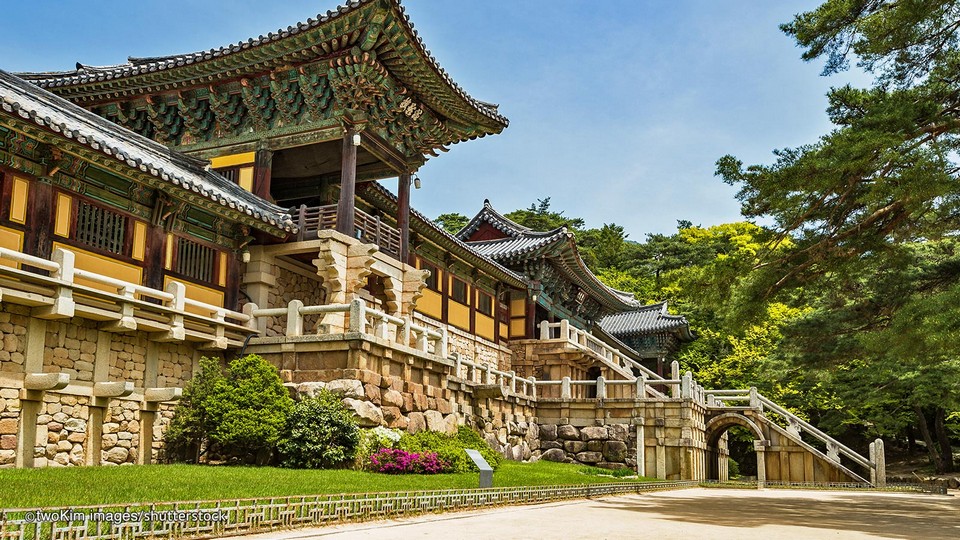
The Bulguksa Temple Complex is 12 km from Gyeongju National Museum and includes both Bulguksa Temple and Seokguram Grotto. The site is recognized as a UNESCO World Heritage Site for being “a masterpiece of Buddhist art in the Far East”.
A historical site closely related to the Silla dynasty is the Bulguksa Buddhist monastery. Bulguksa is a Buddhist temple complex in the historic city of Gyeongju consisting of a series of wooden buildings on raised stone steps designed to represent the land of the Buddha. The complex is a great look at Buddhist art and architecture. This temple is considered one of the three most beautiful temples of Korea.

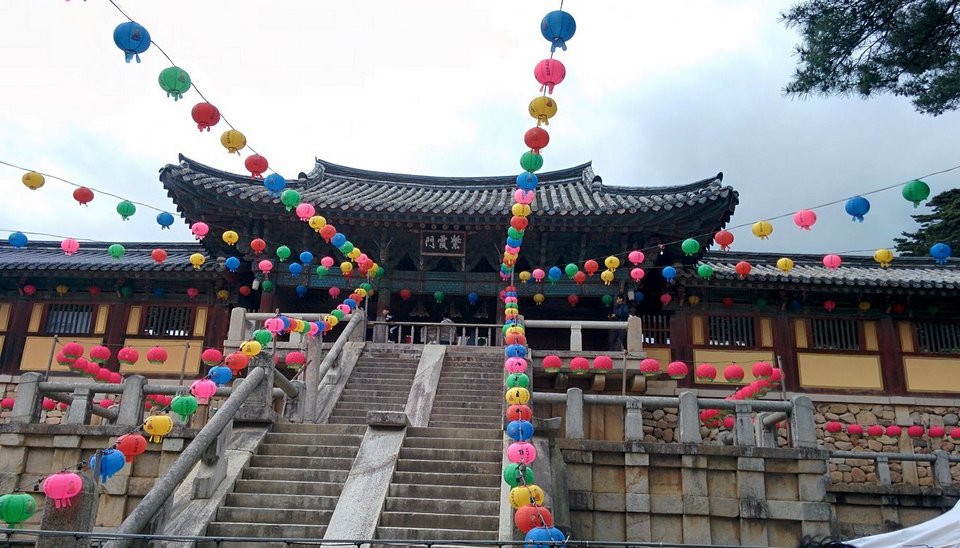
Bulguksa means “Temple of the Buddha Land” was completed in 774, the monument complex gives visitors a very different feeling compared to Buddhist temples in other places.
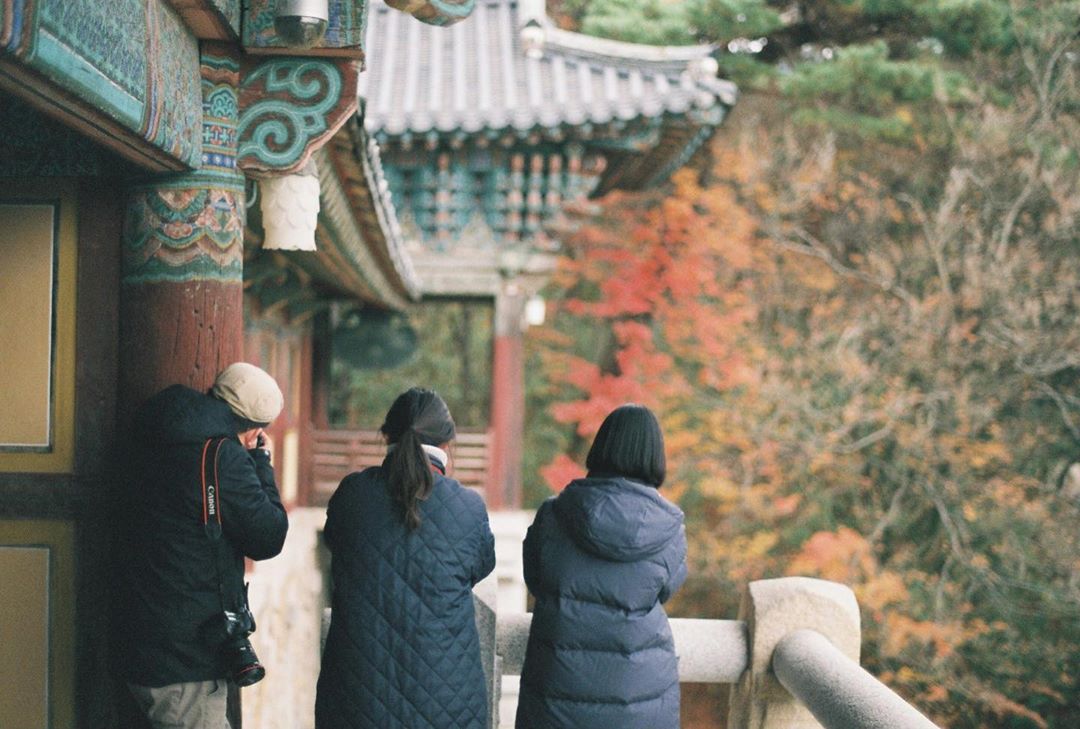
Bulguksa Buddhist Temple is also a favorite place to visit for young people and students in many parts of Korea. They believe that before the exam, coming here to pray will bring good luck, academic career will open.
Bulguksa Temple is known for its ancient and massive architecture. The elaborate carvings on the stone of this temple create a unique beauty that makes tourists keep admiring. Besides the unique architecture, the scenery around Bulguksa Temple in spring or autumn is likened by tourists to a poetic natural picture.

Did you know that the construction of the temple was started in 528, but it was not completed until 774. Experiencing many historical events, the temple has been repaired and rebuilt more than 40 times. The temple is a historical proof of the glorious Silla era. If you go to Korea, remember not to miss this historical place.
With a prime location of the monastery surrounded by extremely rich vegetation, the outstanding red maple forest is always changing colors four seasons all year round.
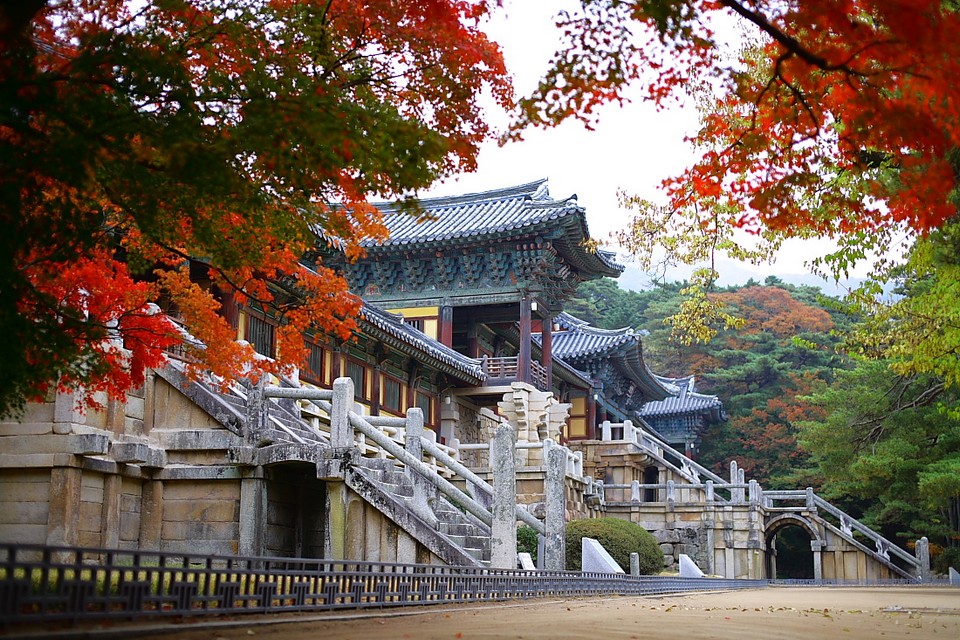
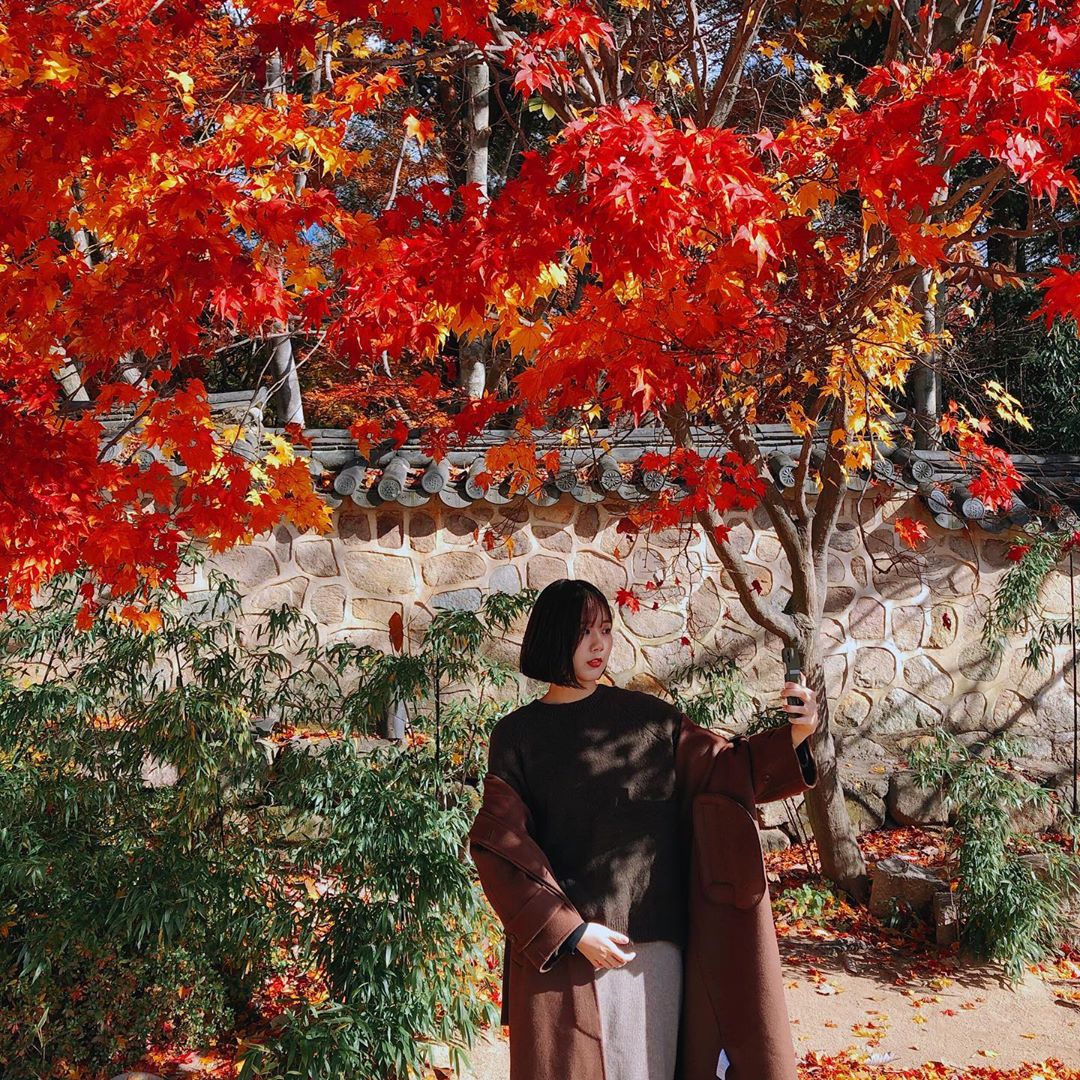
Address: 15-1 Jinhyeon-dong, Gyeongju-si, Gyeongsangbuk-do, South Korea
Hours: 7:30AM–5PM
Seokguram Grotto
Seokguram Grotto is a refuge and national treasure. It was founded in the 8th century and features a huge statue of Buddha overlooking the sea with his left hand in Dhyana Mudra (Gesture of Meditation), and right hand in Bhumisparsha Mudra (the Earth Touching Gesture). The grotto also has statues of gods, bodhisattvas and disciples sculpted on the surrounding walls, considered a masterpiece of East Asian Buddhist art.
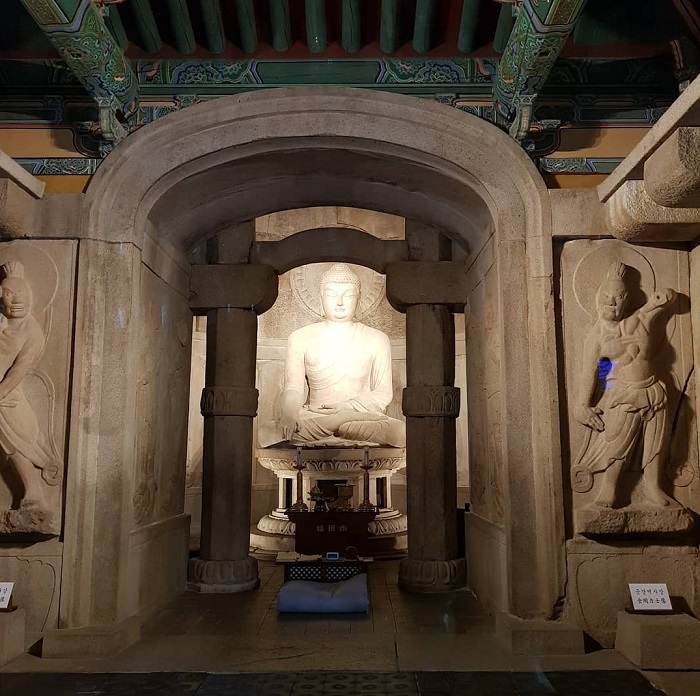
If you have visited Bulguksa Temple, you definitely cannot miss the opportunity to explore Seokguram grotto. This grotto is located about 4km from Bulguksa Temple and has also been recognized by UNESCO as a world heritage site. Seokguram is actually more than an ordinary cave. This is a temple built inside a rock cave. Seokguram grotto can be said to be like a treasure of Gyeongju.

Known as the 24th national treasure of Korea, Seokguram Buddha grotto has gradually become an indispensable place in the travel list of many foreign tourists. It is also a place for scholarly research and pilgrimage.
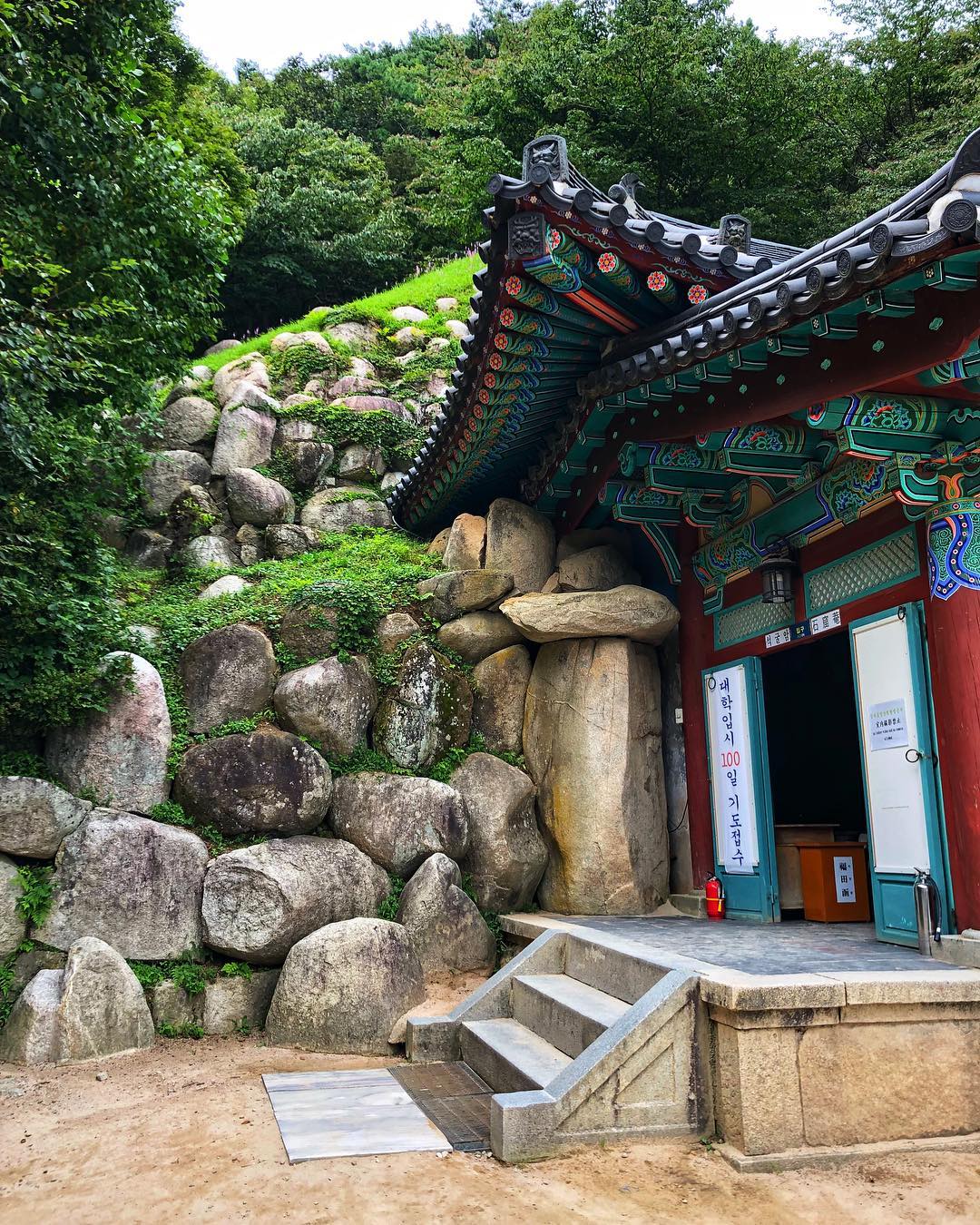
Address: 873-243 Bulguk-ro, Jinhyeon-dong, Gyeongju-si, Gyeongsangbuk-do, South Korea
Hours: 9AM–5:30PM
Cycling around the old town
In Gyeong Ju, the most enjoyable thing is cycling around the center of the old town, both sightseeing and visiting the ruins, relics… Gyeongju Old Town is a national historical site, specially preserved by the Korean government. Korea pays great attention and invests in the preservation of traditional culture. On the main roads in the center of Gyeongju old town, houses, shops, cafes, bus stops… are all built with antique brick roofs and buildings with no more than 3 floors.
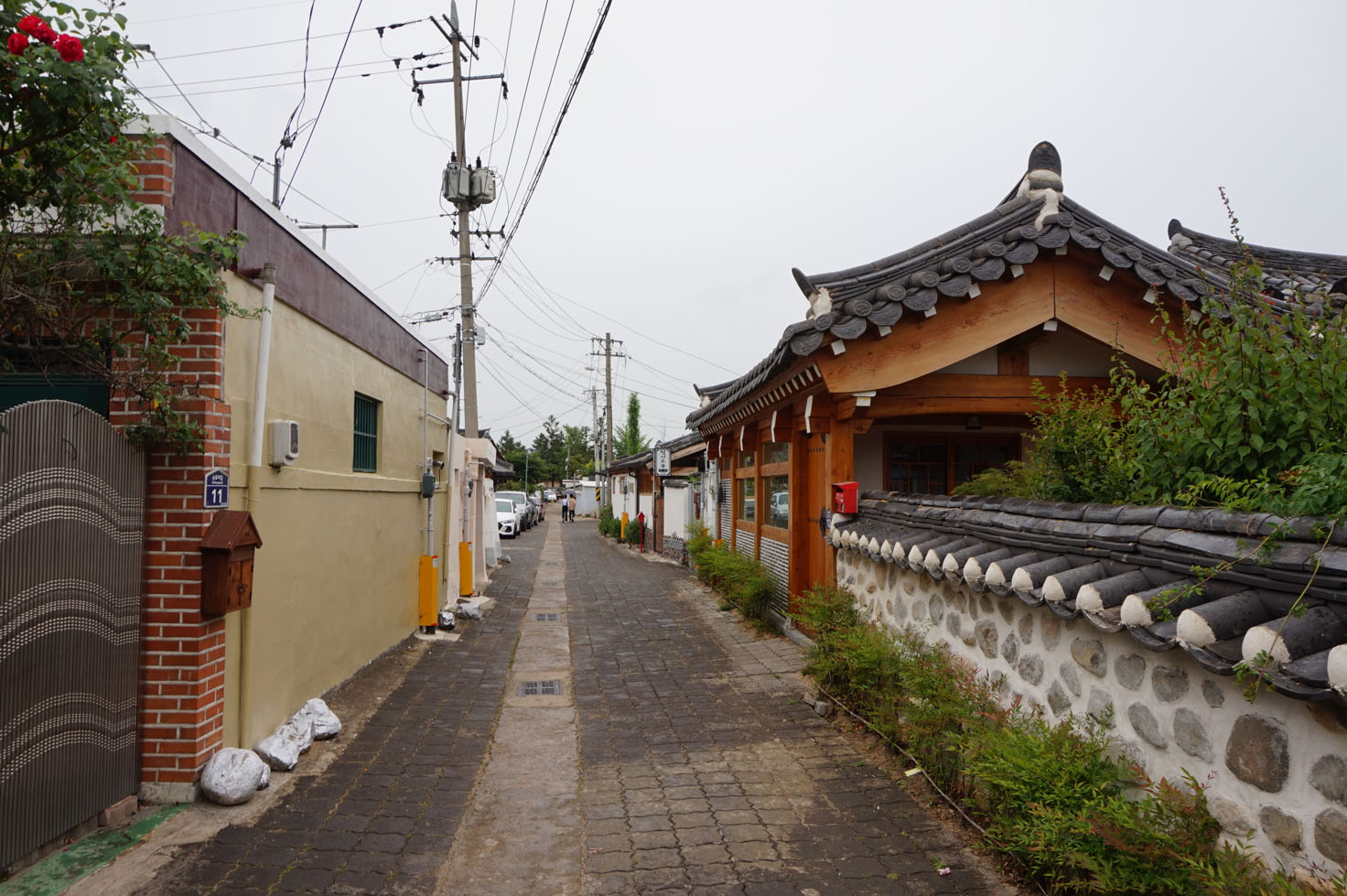
Cafes
In the afternoon in Gyeongju, I also had nothing to do, so I walked around the cafes. Do Not Disturb Bakery & Cafe is a lovely place to try because located in 2 old houses with 1 floor with delicious Western cakes & drinks, I really want to come back to try the black sesame coffee. Drink it like coffee with milk cream layer, but this milk cream is mixed with black sesame, which is my favorite ingredient. You also visit Starbucks with its design in Gyeongju style.
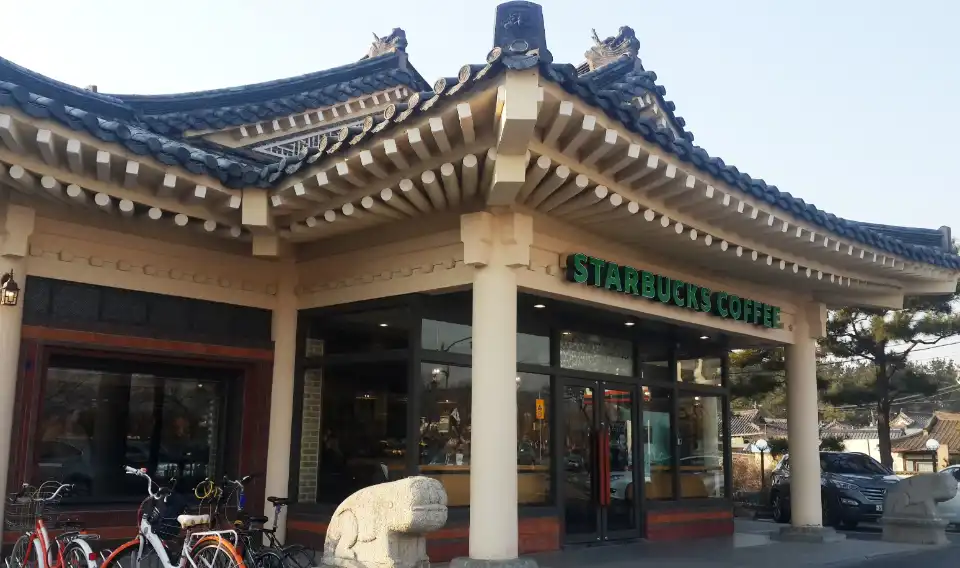
Cafe Eyst 1779 is another shop I was impressed by the beautiful red brick space. This place has outdoor and indoor sitting space with large glass overlooking the bonsai outside. The restaurant’s water is not very impressive, but the space here is very suitable for sitting for a long time to chill and talk.

Visit nearby spots when traveling to Gyeongju
Take the bus around 2 hours 30 minutes north, there Hahoe Folk Village (Address: 186 Jeonseo-ro, Pungcheon-myeon, Andong, Gyeongsangbuk-do, South Korea/Hours: 9AM–6PM) in Andong, North Gyeongsang Province. Andong province is also famous for Jjimdak (Korean Braised Chicken with noodles), very very very delicious, this dish is currently could not made by Korean restaurants in Vietnam. Haeinsa Temple in South Gyeongsang is located to the west and is about 2 hours and 30 minutes by road from Gyeongju, both of which have been recognized by UNESCO as a world cultural heritage and can be reached from GyeongJu in a day.
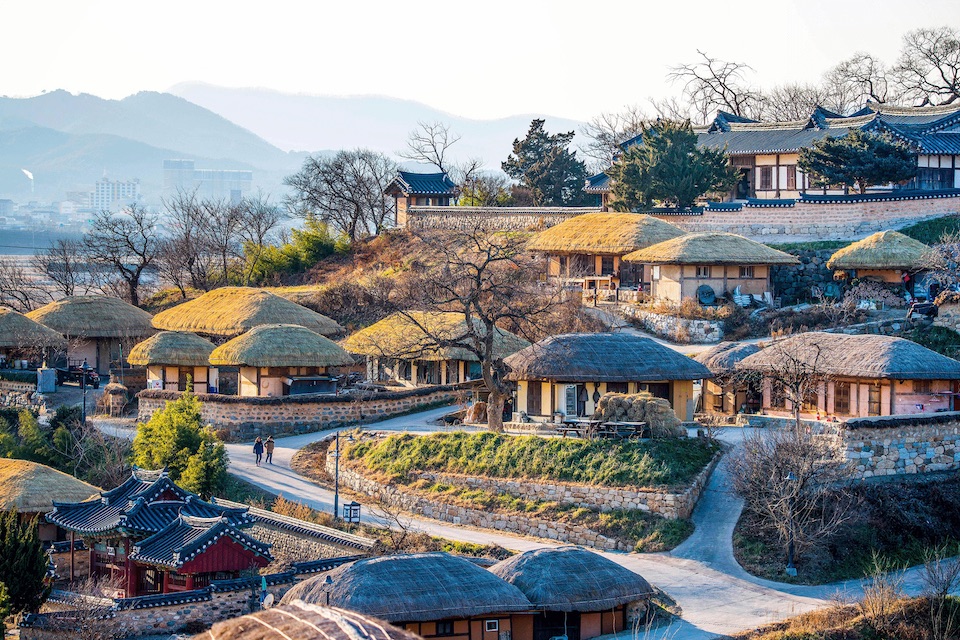
In Korea, there are many ancient villages and houses, but not all of them are the same, but going after a while is also a bit boring, temporarily for future trips to Korea.
Where to eat in Gyeongju?
If you are a foodie and are wondering about food, the food in Gyeongju in general is typical of the cuisine of other places in Gyeongsang Province. However, they do have local specialties including Gyeongju bread, a red bean paste cake, and beopju, a traditional Korean liquor.
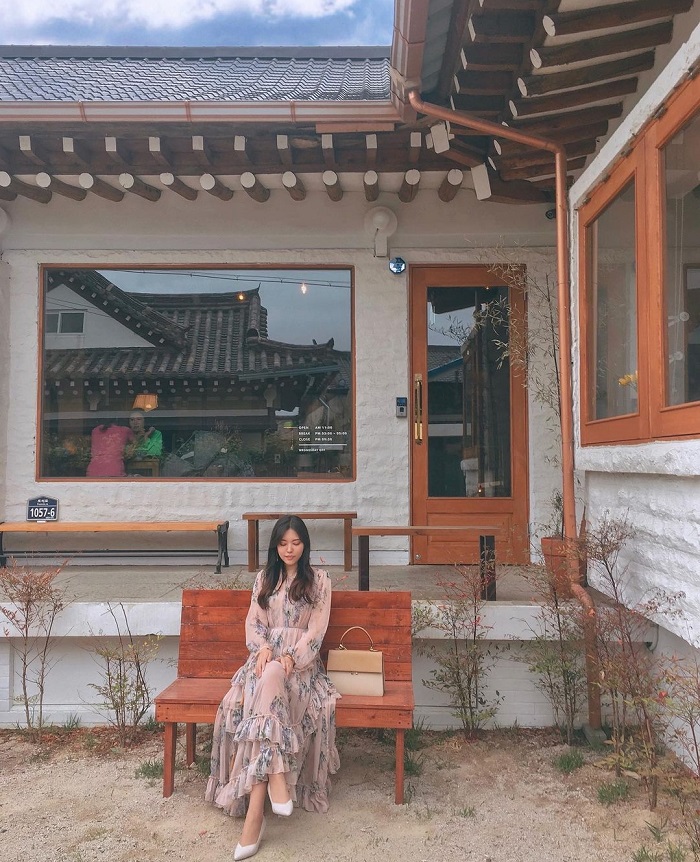
If you’re looking for seafood, head to Gampo-eup, a seaside town in the eastern district of Gyeongju, where you can enjoy fresh seafood and jeotgal (fermented salted seafood). You will find hundreds of seafood restaurants along Gampo port where you can enjoy raw fish dishes, abalone soup, grilled seafood…
If you’re craving traditional Korean food, check out these restaurants:
Hongsi Hanjeongsik (Address: 418-4 Seonggeon-dong, Gyeongju-si, Gyeongsangbuk-do, South Korea/Hours: 11:30AM–9:30PM; Wednesday: 11:30AM–3PM): It’s a bit far from the main attractions in Gyeongju, but well worth a visit if you’re looking for a traditional Korean food experience.
Sukyoung Sikdan (Address: 60 Gyerim-ro, Gyeongju-si, Gyeongsangbuk-do, South Korea/Hours: 11AM–3PM, 5–8PM; Tuesday: Closed): This is the vicinity of Daereungwon Tomb Complex and the restaurant serves pajeon (green onion pancakes) and dongdongju (rice wine).
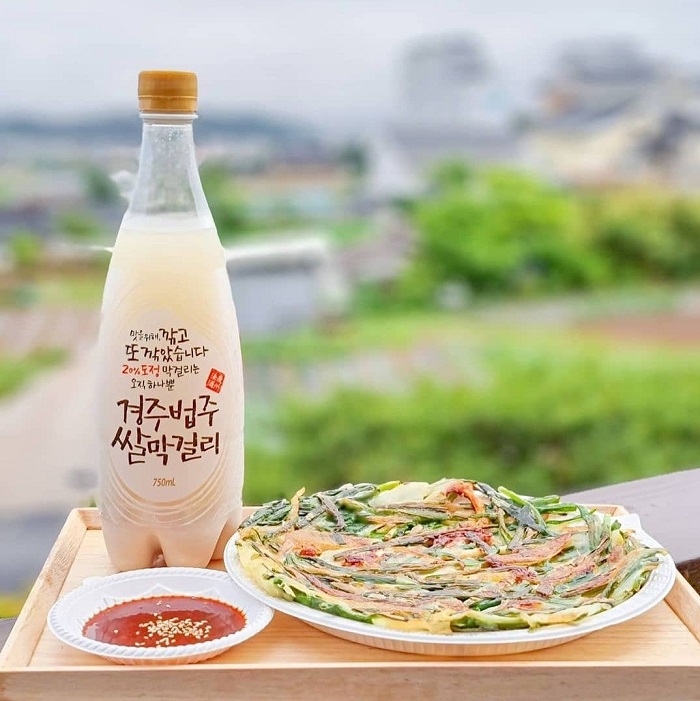
Dosolmaeul: This is another traditional restaurant serving seafood and various stews. If you want to try a variety of traditional Korean dishes, you can order a meal from their menu.
Below are some dishes you should try in Gyeongju
Ssambap (Korean Rice Lettuce Wraps): A dish made from rice and meat wrapped in lettuce leaves, it has both the spicy and sweet taste of sugar and the sour taste of kimchi.
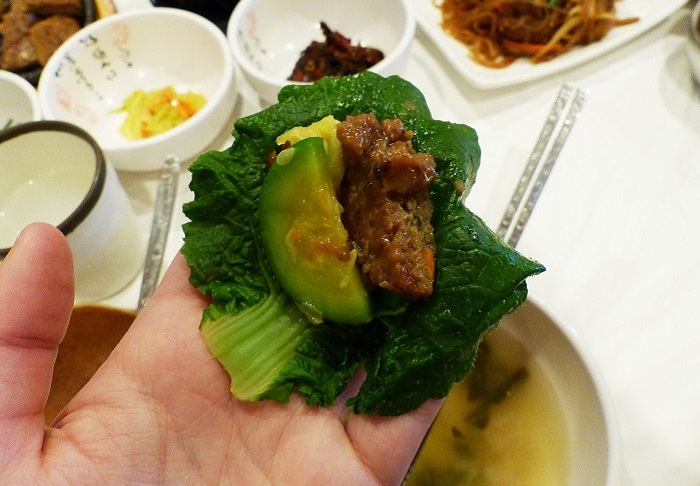
Barley bread: Barley flour pancakes have a very delectable red bean filling. Enjoy this cake to feel the sweet and chewy taste filling your mouth.
Hwangnam bread (Hwangnam-ppang): Called Hwangnam bread because this bread is most famous in the Hwangnam-dong region, neighboring Gyeongju. It’s still a sweet red bean paste stuffed inside a thin crust, but once you try it, it doesn’t look like the barley bread above at all!

What to buy as a gift after a trip to Gyeongju? (#what to do in gyeongju)
Do not to forget to buy chocolate and bread as gifts after the trip. However, you should also note that their shelf life is not too long, bread can only be eaten in about 2-3 days after that.
Visitors are suggested to buy Silla smiley bread. This red bean and blueberry pie has a lovely look. Their shape also follows the prototype of tiled roofs made in the Silla period with a smiley face engraving.
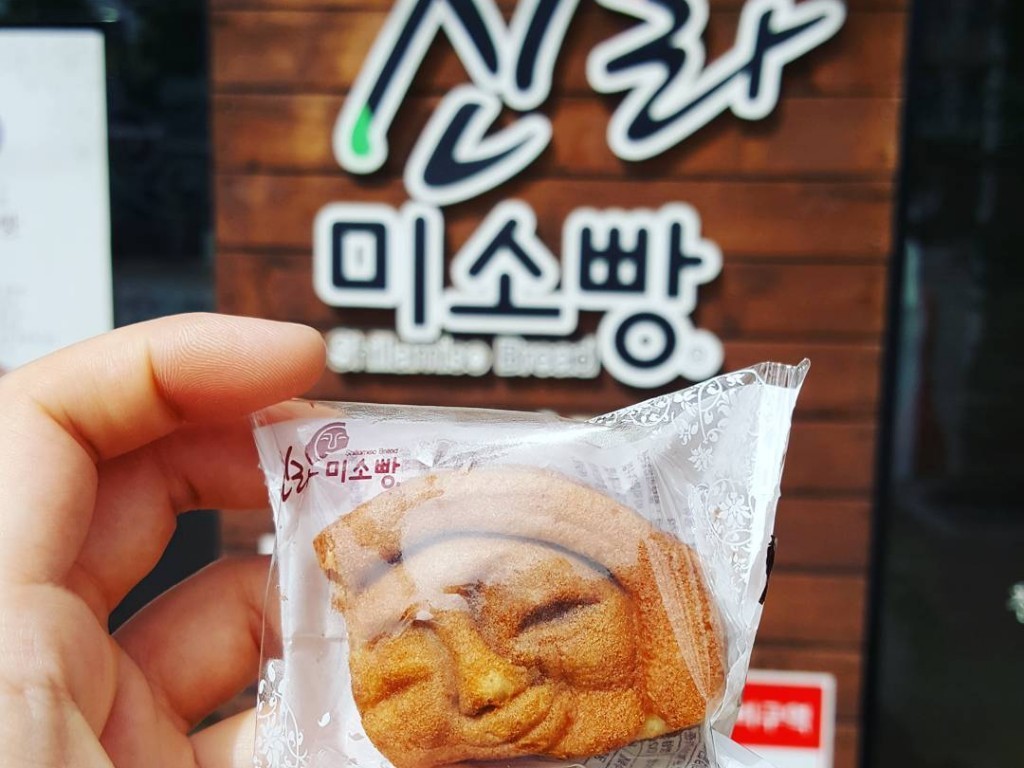
Cheomseong Walnut Bread is also impressed by the shape simulating the Cheomseongdae Observatory. Although called bread, there is a recipe for rice cake. Red bean paste is added to the cake to add color and flavor.
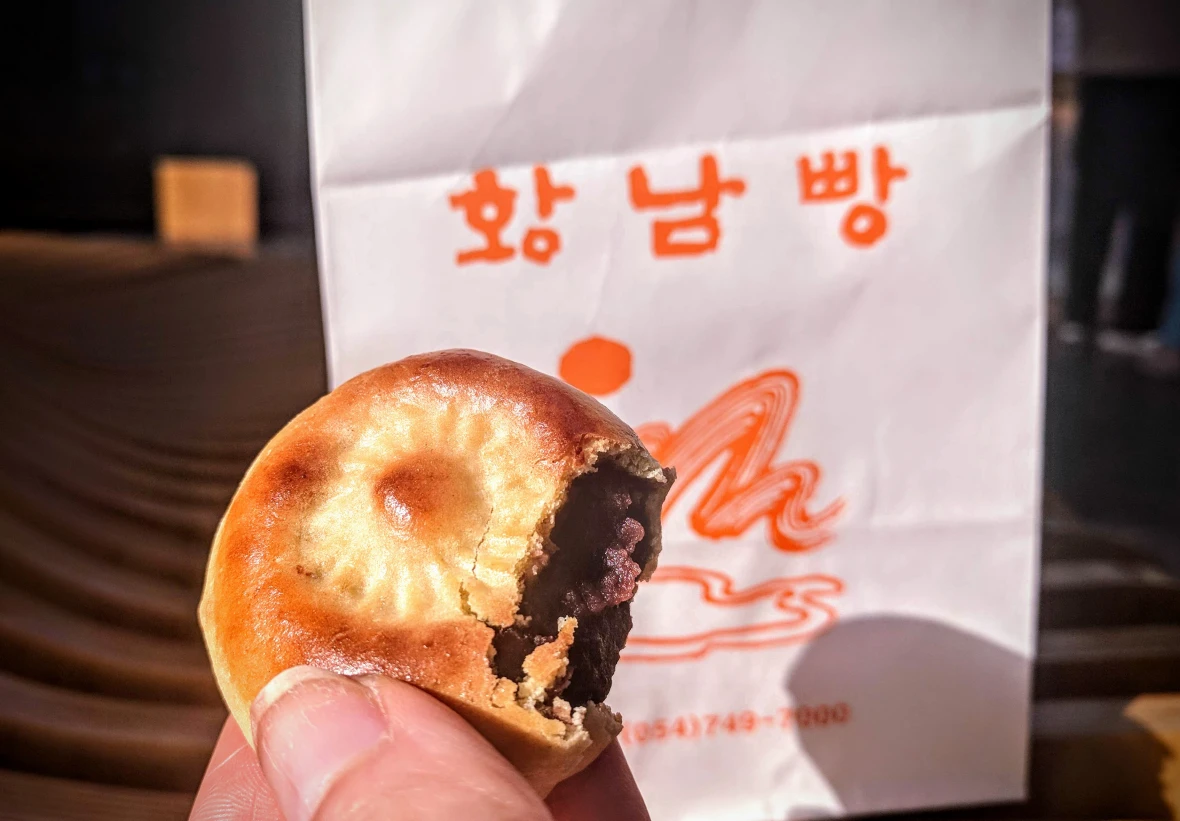
Cheomseongdae Chocolate: Not only walnut bread, Gyeongju’s most popular chocolate also has the shape of Cheomseongdae Observatory. In addition to traditional dark chocolate, this chocolate candy also has very attractive green tea and coffee flavors.
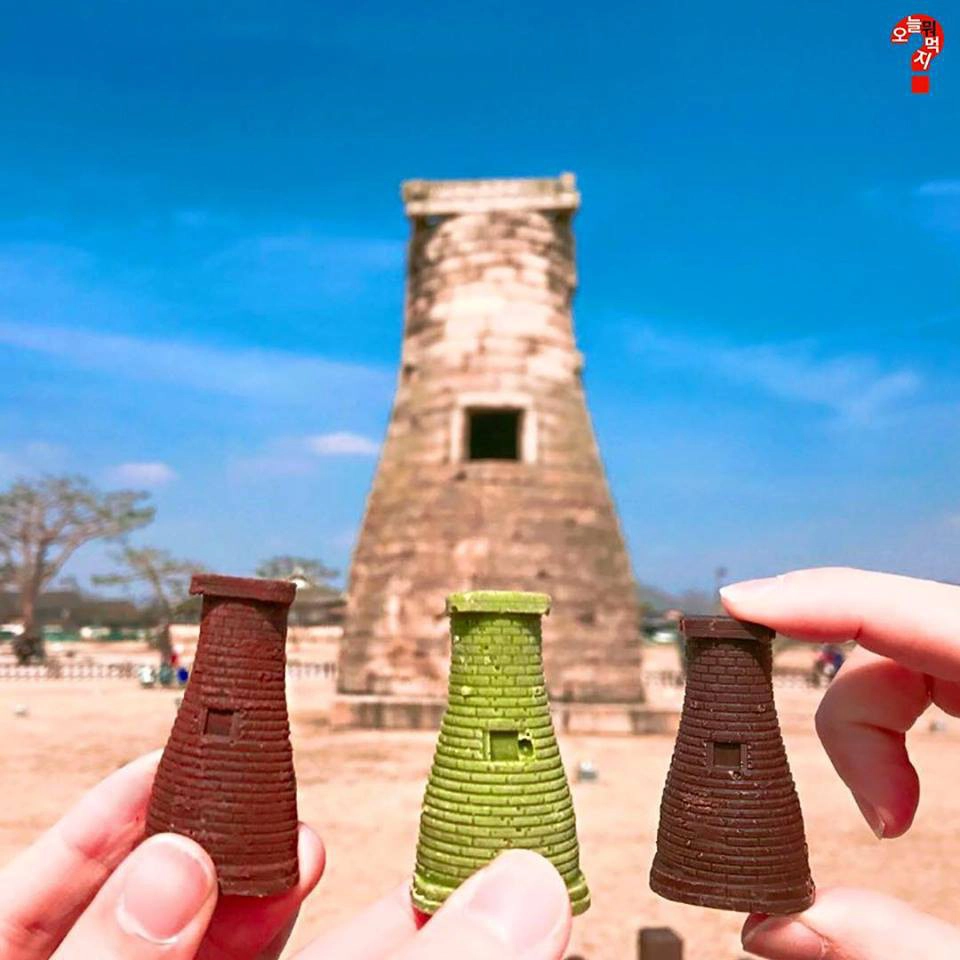
Where to stay?
Gyeongju has no shortage of room types for you to stay overnight. It only depends on your financial conditions and the experience you want to have that you choose the right accommodation.
In the center of Gyeongju, right after Gyeong Ju Bus Terminal, there are all kinds of hostels, guesthouses, homestays… quite affordable and convenient for traveling, eating, and sightseeing. The price of these accommodations is around 50,000 won/night.
Luxury hotels such as Hilton, Commodore are concentrated around Bomun Lake – the entertainment area in the east of the city. Overnight price from 300,000 won.
Some 5-star hotel, resort with many theme parks (theme parks), water parks, a bit far from the old town a little bit…, suitable for people traveling with family, both entertainment and visit ancient ruins with modern types of entertainment. The Gyeongju Tourism Department is indeed ingenious in combining resort tourism – discovery – culture in one destination.
I had the opportunity to travel Gyeongju twice, the first time was during winter in backpack style, stayed at a hostel near the bus terminal for $38/night, shared with my friend, $16 each. The second time was traveling by invitation of the association, staying alone in a $280 room in the Grand Hilton hotel. Going to Gyeongju, but two completely different experiences, the experience of backpacking or going luxury is also fun, seeing Gyeongju under different lenses.
Below we recommend more best budget, mid-range and upscale hotels with good ratings and reviews you can refer to.
- Lahan Select Gyeongju (Agoda, Booking)
- Commodore Hotel Gyeongju (Agoda, Booking)
- Hilton Gyeongju (Agoda, Booking)
- Mini Hotel 141 (Agoda, Booking)
- Gyeongju GG Tourist Hotel (Agoda, Booking)
- Maison Mini Hotel (Agoda, Booking)
- MTM Family Hotel (Agoda, Booking)
Check out more top and best hotels on Agoda.com or Booking.com
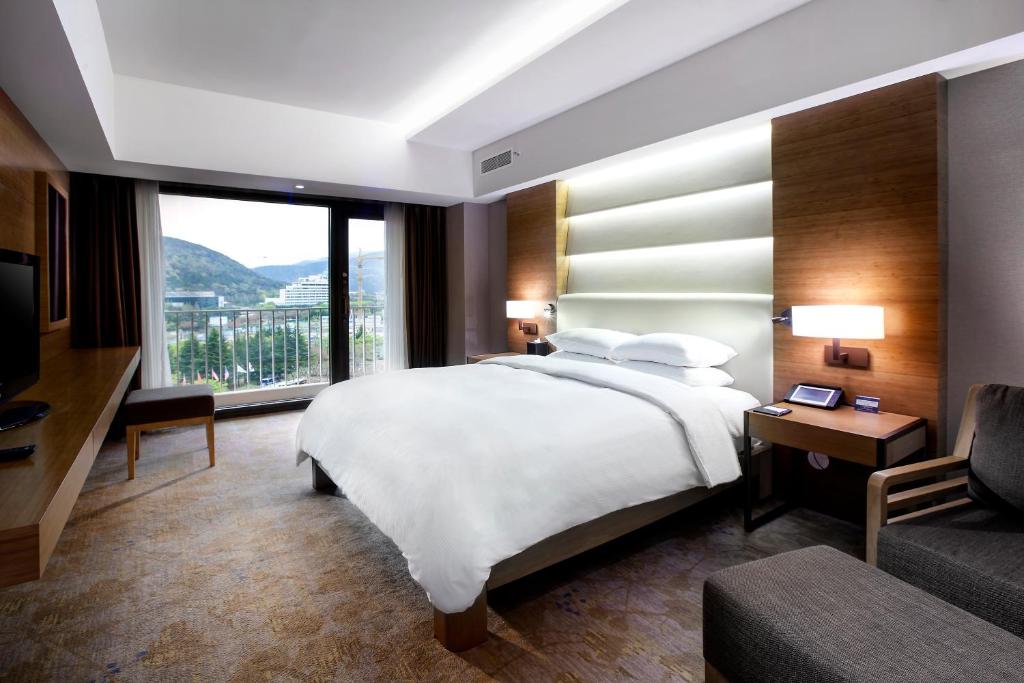
After 3 days and 2 nights, I also returned to Seoul. Gyeongju is clearly the opposite of megacities. Gyeongju is a beautiful, peaceful country town and nature bestows this place with the most beautiful skies. Although the night is somewhat gloomy, during the day Gyeongju lights up with its slogan “The Golden City”. For me, Gyeongju is a destination not to be missed on the tourist map of Korea. If I have the opportunity, I want to go back to Gyeong Ju in the spring to see the cherry blossoms blooming around Bomun Lake. Here spring is the most beautiful scene, cherry blossoms bloom around Bomun Lake, very beautiful. Gyeongju is probably a place I would want to come back and stay longer, to heal myself. Hope everyone has the opportunity to go to Korea, don’t forget to visit Gyeongju!
Some best day tours, trips, activities and transfer services, tickets in, from and to Gyeongju you can refer to
- Gyeongju UNESCO World Heritage Site, Seokgulam, Bulguksa Temple Day Trip from Busan
- A Day in Gyeongju by TK Travel
- [Gyeongju One-Day Tour] The old capital of Korea with a thousand years of history [Departure from Busan]
- Gyeongju Historical Daereungwon Royal Tomb Complex, Yangdong Village, and Anapji Full Day Tour from Busan
- Gyeongju Historic Sites Day Tour from Seoul
- Bulguksa, Daereungwon, Huanglidan, Gyochon Village, Woljeong Bridge, Cheomseongdae Gyeongju Tour from Busan
- Gyeongju Private One Day Tour from Busan
- Busan & Gyeongju Private Customized Tour
- 2D1N Gyeongju Historical and Cultural/Autumn Leaves Tour from Seoul by TK Travel
- Gyeongju Historical Tour from Busan
- [Special Promo] Train to Busan Horror House Combo Admission Ticket
- 4G Prepaid SIM Card (SK Airports Pick Up) for South Korea
- [Sale] Hanbok Experience (Hanboknam Gyeongbokgung Store) with Korean Hairstyling
- [SALE] South Korea 4G Pocket WiFi (KR Airports Pick Up) from KT Olleh
- 4G WiFi (MY Airport Pick Up) for South Korea (Unlimited Data)
- 4G Portable WiFi for South Korea from Uroaming (Unlimited Data)
- [SALE] Instant Ticket: Korea Rail Pass (KR PASS) 2/3/4/5Days
- [Limited Offer] Incheon International Airport (ICN) Luggage Services (Between Airport and Hotel) by Safex

Are you looking for more Busan travel guide: Things to do, activities, attractions and other things? Let’s check it out our Busan blog — The fullest Busan travel guide & suggested Busan itinerary on how to spend 3 days in Busan, South Korea.




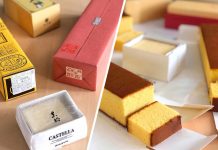


























![10 best airports in Asia in 2016 [RANKED] kuala-lumpur-international-airport-best airports in asia in 2016 by skytrax ratings](https://livingnomads.com/wp-content/uploads/2016/08/29/kuala-lumpur-international-airport-best-airports-in-asia-in-2016-by-skytrax-ratings-218x150.jpg)








